










































At Trailer Bridge we understand that it’s about more than transporting a box on wheels, it’s about delivering the goods our neighbors need in their everyday lives. Whether it’s food on the table or new living room furniture – every load matters.

That is why we focus on delivering exceptional service to our customers ensuring each load is handled with care. Consider us your partner and lean on us for anything, anytime – because we believe it’s not just business, it’s personal.
Connect with us today and let’s take a look at how we can support your supply chain needs.







Brian Everett, Publisher Senior Partner, MindShare Strategies 952-442-8850 x201 brian@mindshare.bz

Volatility and inflation have defined the food chain and logistics landscapes in the past year and a half. Demand in all modes and nodes surged, while the resources, people and assets needed to move and store materials and products remained scarce. In addition, rising costs magnified these challenges. In fact, in 2021 United States business logistics costs alone rose 22.4 percent to U.S. $1.85 trillion, or 8 percent of 2021’s $23 trillion Gross Domestic Product (GDP).
Efficiencies in logistics capacity allocation at contracted rates were compromised by stimulated demand for goods and disrupted supply, resulting in many food shippers having to expedite shipments at premium spot market rates. Rates for transportation services and space in available assets had dramatically risen on the spot market. Providers of all types (3PLs, freight brokers, and carriers of all modes) were challenged to honor capacity commitments at contracted rates given the circumstances. In some situations, there was an eroding of relationships with food shippers that had been built in stabler times.
A quick look at the revenue and profit growth among 3PLs in 2021 demonstrates a significant increase (see illustration below). So what accounts for the accelerated growth among third-party logistics providers,
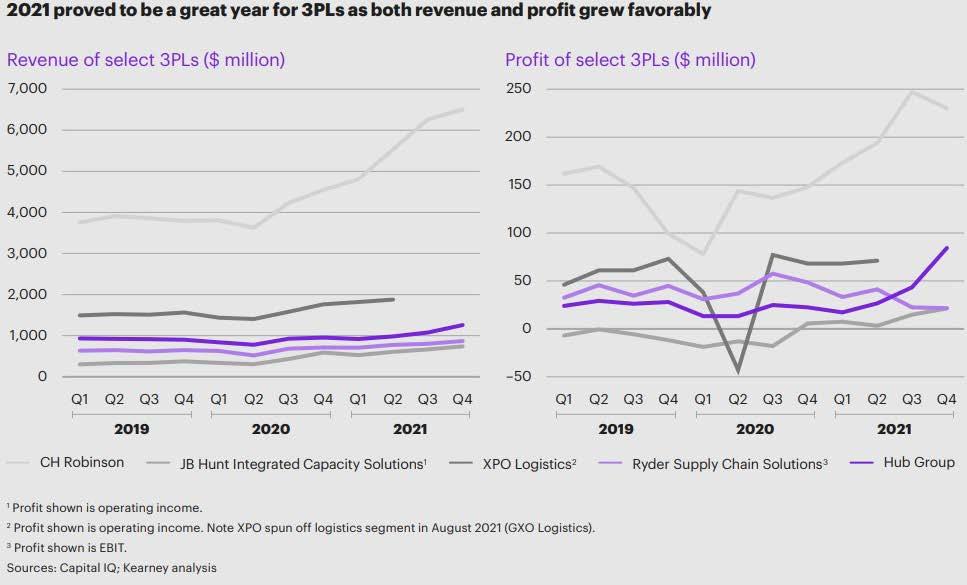
freight brokers, warehousing and distribution specialists, and carriers of all modes? Some of this growth reflects the changing needs and challenges of food shippers – both inbound and outbound. Shippers are coping with many challenges and disruptions thrown their way - ranging from a dramatic jump in consumer demand, shortage of capacity, and the resulting increase in rates for both transportation and warehousing – and they’re turning to outsourcing resources to help them navigate through it all.
It’s clear that today’s food chain challenges are more complicated than ever, and finding the best solutions is
increasingly dependent on shippers and their providers collaborating together in true partnership fashion. The stakes are higher for customers and the opportunity to drive customer growth during transitional times is even greater, consequently, finding those right solutions is critical. Benefits can be large and demonstrable.
You’ll see this special edition of Food Chain Digest is focused on the valuable relationships between food shippers and their supply chain partners. Make sure to leverage the resources, case studies, and market intelligence you’ll find in this edition to the advantage of your food chain strategy.
2021 proved to be a great year for 3PLS as both revenue and profit grew favorably
Revenue of select 3PLs ($ million)
Profit of select 3PLs ($ million)
IT’S CLEAR THAT TODAY’S FOOD CHAIN CHALLENGES ARE MORE COMPLICATED THAN EVER, AND FINDING THE BEST SOLUTIONS IS INCREASINGLY DEPENDENT ON SHIPPERS AND THEIR PROVIDERS COLLABORATING TOGETHER IN TRUE PARTNERSHIP FASHION.
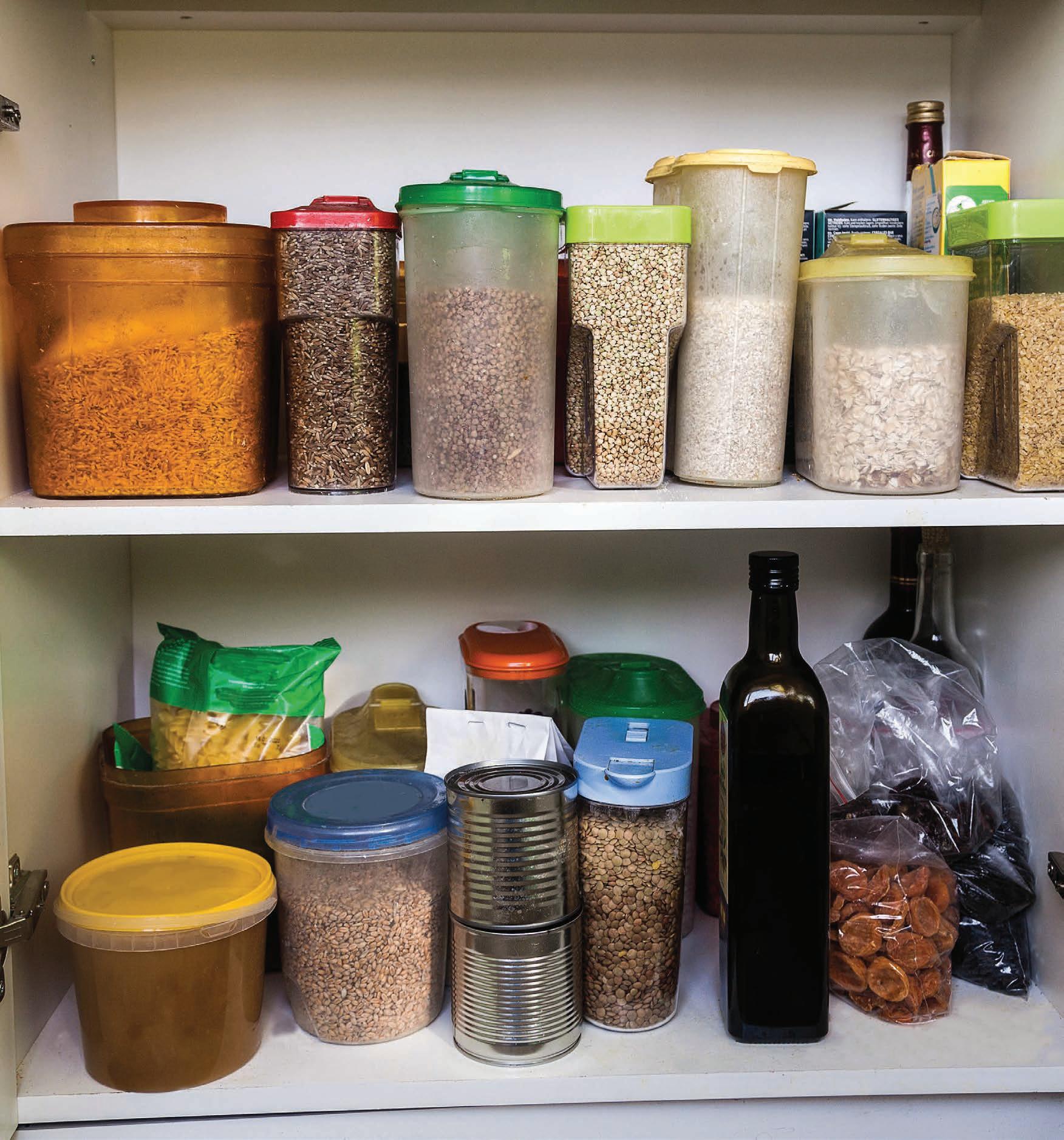

Well, it is hard to believe that 2022 is just a few months from being over and that the holidays are just around the corner. And, as food shippers, that also means that the 2023 Food Shippers of America Conference is approaching just as quickly. Our 67th annual conference planning is well underway. Mark Purdy of General Mills and Craig Paulsen of Schneider have put together an exciting and educational line-up of speakers, panelists, and keynotes. Innovate, Collaborate, Accelerate is this year’s conference theme - and yes, I am pumped when I hear this!
In addition to the conference sessions, the team is working to add informative Sunday sessions as well as new and expanded networking opportunities to provide more time for you to spend collaborating with your industry peers.
I hope you enjoy our Edition 3 of Food Chain Digest - which is loaded with timely and relevant content with multiple articles that cover current market and industry trends, discussion on supply chain disruption and emerging technologies in the warehouse space, and highlights best practices and perspectives by

such leading shippers as General Mills, Conagra Brands and Mondelēz International.
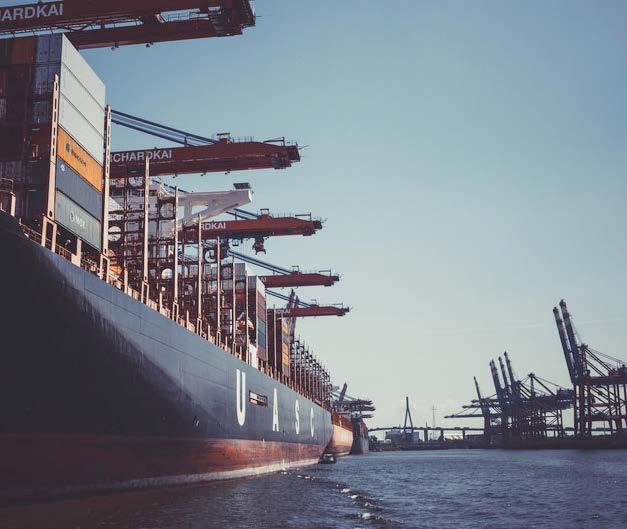
FSA also is accepting scholarship applications for our 2023 awards. Eligible applicants are children or dependents of employees of FSA member companies that are in the supply chain or logistics departments. Applications can be requested on the FSA website at foodshippersofamerica.org.
Thanks to everyone that has already registered for the 2023 FSA Conference. I look forward to seeing you all in Palm Desert!
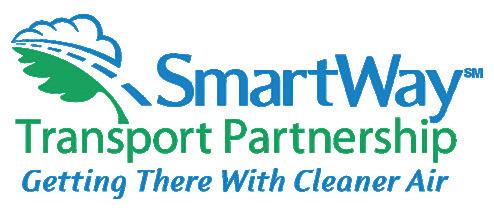
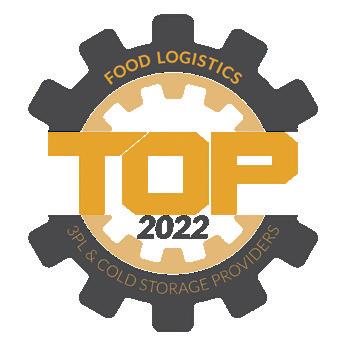





To provide food shippers with a better perspective of the freight economy and the logistics marketplace in upcoming months, Food Chain Digest reached out to gain perspectives from Avery Vise, Chief Trucking Analyst and Vice President, Trucking for FTR Transportation Intelligence. Here’s what he had to say.

With logistics costs continuing to increase in Q4, what are the primary factors that are driving these escalating costs?
We do not expect sharply higher logistics costs for Q4 as freight rate pressures are subsiding due to softer overall freight demand and greater capacity, especially in truckload. On the other hand, we believe logistics cost relief is speculative in Q4 as those downward pressures collide with ongoing disruptions in the supply chain and labor market and higher demand during the quarter, especially for food. Shippers should prepare for modestly higher costs, but they could be pleasantly surprised.
However, fuel costs remain a wild card as volatility returned in late August. Also, distillate inventories remain low by historical standards, which is potentially problematic
heading into the home heating oil season.
What do you anticipate the logistics marketplace will look like in Q4 of 2022?
A shift of trucking activity and capacity during 2022 back into normal route guides from the spot
market has helped settle rates and capacity, but Q4 still could see some stresses. Perhaps most notable are chronic rail service congestion issues that will limit the ability of the intermodal segment to handle as much peak demand overflow as usual.
Due to the profile of intermodal freight, packaged dry goods and food would see the largest impact. However, increased use of poweronly logistics solutions in recent years means that truck capacity in the spot market has never been more fluid. While this situation has advantages for shippers, it also means that freight segments can experience capacity shortfalls more readily due to spikes in demands in other segments. In other words, if intermodal cannot handle its usual peak season share of traffic, that overflow could affect availability, not only of dry van capacity but also capacity in refrigerated and possibly even in some specialized segments.
What do you anticipate the logistics marketplace to look like longer term into 2023?
Shippers should see relatively more stability once we get past the 2022 peak season. Labor stresses have dissipated in trucking, and equipment constraints also are starting to let up. Rail carriers have been making incremental progress in adding head count, but they face multiple hurdles in improving service and velocity.
Although seasonally adjusted spot market volume for refrigerated freight has dropped sharply in 2022, FTR estimates that total seasonally adjusted refrigerated volume has been stable. Dry van has followed the same basic pattern. The cooling spot market does not indicate a drop in overall freight, but rather a shift of activity from spot to contract as capacity has increased in the contract arena.
Shippers should not have too much difficulty sourcing truckload capacity in Q1 at least in 2023, but the market could get incrementally tighter as the year wears on. Even so, we do not envision anything remotely like the stress seen in 2021.
Spot rates look to be down by double-digit percentages again in 2023, likely producing rate levels

that are stronger than they were in 2019, but not as strong as they were in 2018. FTR is forecasting contract rates to remain quite strong in 2013, however. While we see them declining about 5 percent year over year, that follows year-over-year gains of more than 13 percent in 2021 and around 8 percent in 2022.
LTL contract rates also look to give back some of their robust rate gains, but as with truckload, we are forecasting a high floor. LTL has a fairly wide range of outcomes, however, as the manufacturing sector has significant risks both to the upside and downside.
What advice do you give providers and carriers to successfully navigate through this anticipated logistics/freight market?
Watch for signs that the market is not behaving as expected in a postpeak environment. Surging diesel prices in the spring were a catalyst
for many drivers to return to the security of working for larger carriers, but digital freight matching and legal threats to the leased owner-operator model could keep spot capacity and activity elevated. While this scenario could help maintain a floor on rates, it also might make it more difficult for carriers to honor capacity commitments. Carriers might find active logistics divisions valuable assets.
What advice do you provider shippers to successfully navigate through this anticipated market?
The recent softening of the freight market is untested by a holiday peak season, so shippers are not out of the woods in terms of capacity shortfalls or near-term freight rate spikes. At least through Q4, shippers would be smart to treat the freight market as if it were still 2021, using the same day-by-day and hour-by-hour tactics that kept their goods moving at the
peak of the market. For shippers invested in holiday-related purchases – whether consumer goods or food –the fourth quarter of 2022 probably is not a time to get overly aggressive with carriers.
Q4 offers a wide range of possible outcomes because of macroeconomic issues, especially inflation and its potential impact on consumption. So far, soaring inflation has flattened out consumption on a unit basis, but consumer spending on goods is only marginally weaker when adjusted for inflation. Consumers overall still are in an extraordinarily strong financial position with lots of cash and low levels of debt relative to disposable income. Even with the “doom and gloom” pronouncements in many quarters, holiday spending and associated freight demand could be robust.

"Consumers overall still are in an extraordinarily strong financial position with lots of cash and low levels of debt relative to disposable income. Even with the “doom and gloom” pronouncements in many quarters, holiday spending and associated freight demand could be robust." - Avery Vise
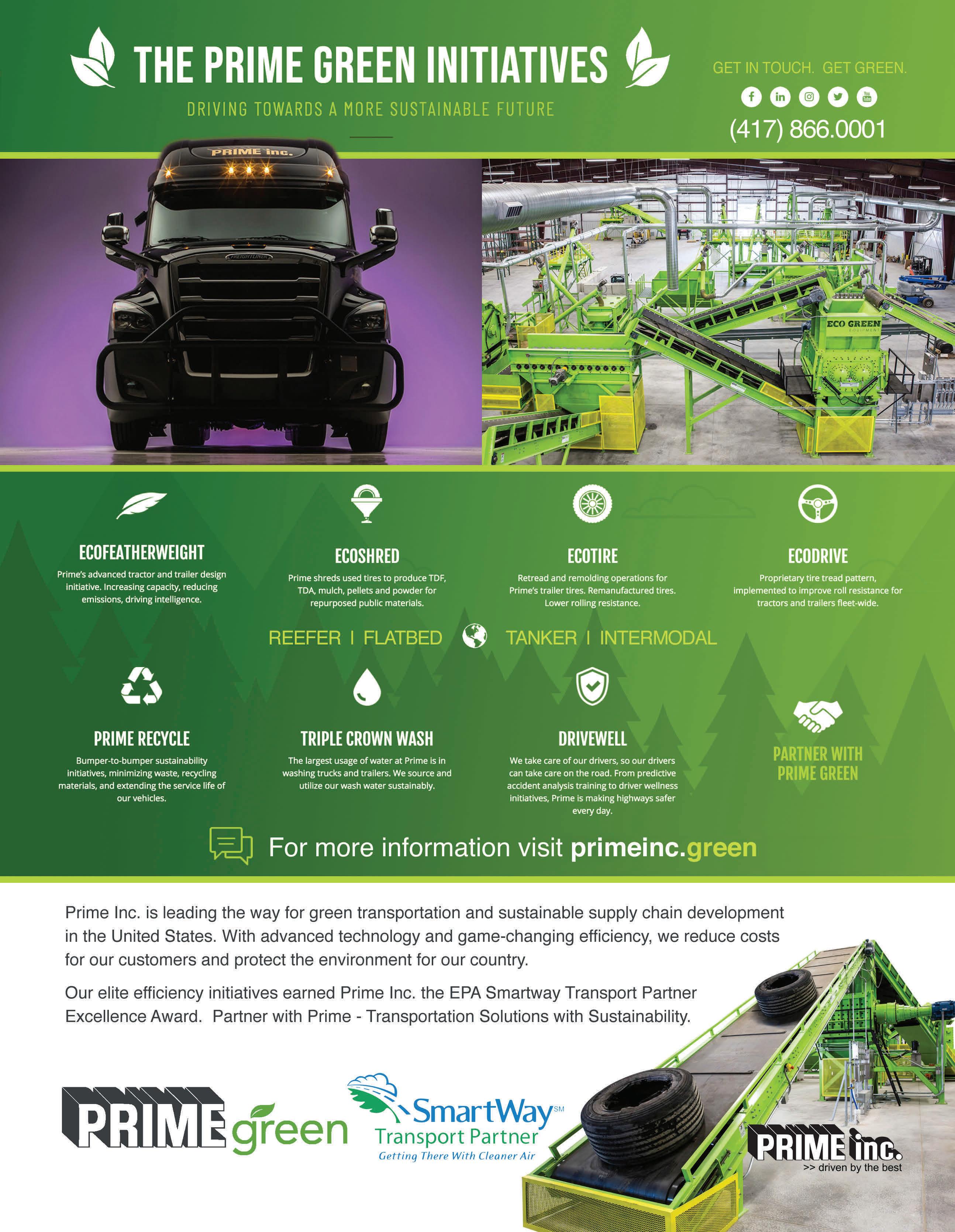

Shippers have increasingly sought the assistance of their “provider partners” in navigating a baffling blend of food chain complexity, service disruptions, scarce capacity, and surging customer demands.
Through it all, the role of provider partners is becoming markedly more valuable as the economy adapts to the explosive growth of e-commerce, nearshoring and
reshoring, and the push to improve food chain resilience through diversified supply options.
The nature of the relationship between food shippers and their provider partners has become much more consultative than ever before, whereas in the past providers were often viewed simply as interchangeable commodityservice vendors.
Value-driven relationships between food shippers and providers has never been more evident than the last two years – and this is demonstrated clearly through the 2022 Top Food Chain Providers program which was launched this year by Food Chain Digest, the official magazine of Food Shippers of America (FSA). This program highlights third-party logistics companies (3PLs), freight brokers, motor carriers, rail/intermodal and maritime companies (ocean carriers and port authorities) that excel in capabilities and service to food transportation, logistics, distribution and supply chain management, according to Brian Everett, Group Publisher and Editorial Director of Food Chain Digest
“Food shippers rely upon their logistics partners and carriers to help manage a productive, efficient and seamless food chain,” says Everett. “This is the first year that Food Chain Digest has deployed this recognition program to serve as a resource to food shippers as they secure partners and capabilities in managing their supply chain strategy and execution.”
Here’s how the program works: First, nominations were made by food chain providers and reviewed by the staff of Food Chain Digest. Requirements
of all candidates are that they are a 3PL, freight broker, motor carrier, rail/intermodal provider, or maritime company that generate at least U.S. $5 million in gross global sales. These nominations were evaluated based upon value provided to food shippers, achievements accomplished in the last 12-18 months, and solutions that have helped to solve a business problem of food shippers.
an adequate volume of votes are validated, which helped to identify the companies named to the list. The full list of the 40-plus companies named as 2022 Top Food Chain Providers, along with their category, services, and website, can be found starting on page 16.
Through the nominating and voting process of the 2022 Top Food Chain Providers, there are some common themes to underscore in today’s relationships between food shippers and their service providers. Following these practical tips in determining the relationships with provider partners most meaningful to your food chain strategy:
Forge relationships to have the most meaningful impact on your business challenges. Many providers named as 2022 Top Food Chain
Next, nearly 6,000 participants in the food industry voted for nominated companies that had the strongest reputation and value in the food chain technology segment. As part of the process, companies earning
Providers identified current best practices and examples of how they are helping shippers navigate through the ongoing turmoil of modern-day challenges such as port congestion, driver and capacity shortages, and labor challenges due to the Great Resignation.
The nature of relationships between food shippers and providers of transportation, logistics and warehousing services has been greatly redefined during these unprecedented times.



Look at provider partners who can strengthen your expanding needs. Supply chain challenges and disruptions like the ones listed above have left food shippers more open to outsource management of their logistics and activities they deem noncore in their operations. In addition, the continued growth in e-commerce has driven more demand by shippers for other value-added services such as reverse logistics and final-mile delivery. Are your current partners able to augment your current capabilities and expanding core business needs?
Assess where warehousing and distribution fit into your overall supply chain strategy. In response to rising demand for last-mile fulfillment, there is a growing need of compact, strategically distributed warehouse spaces suited to customer picks. There’s a trend of food chain providers to weave this fast-growing niche into their growth strategy. While this is hardly the only warehousing subcategory that is growing, 91 percent of food shippers and 100 percent of 3PLs expect demand for cold chain capacity to increase over the next three years, according to the 2022 Annual Third-Party Logistics Study.
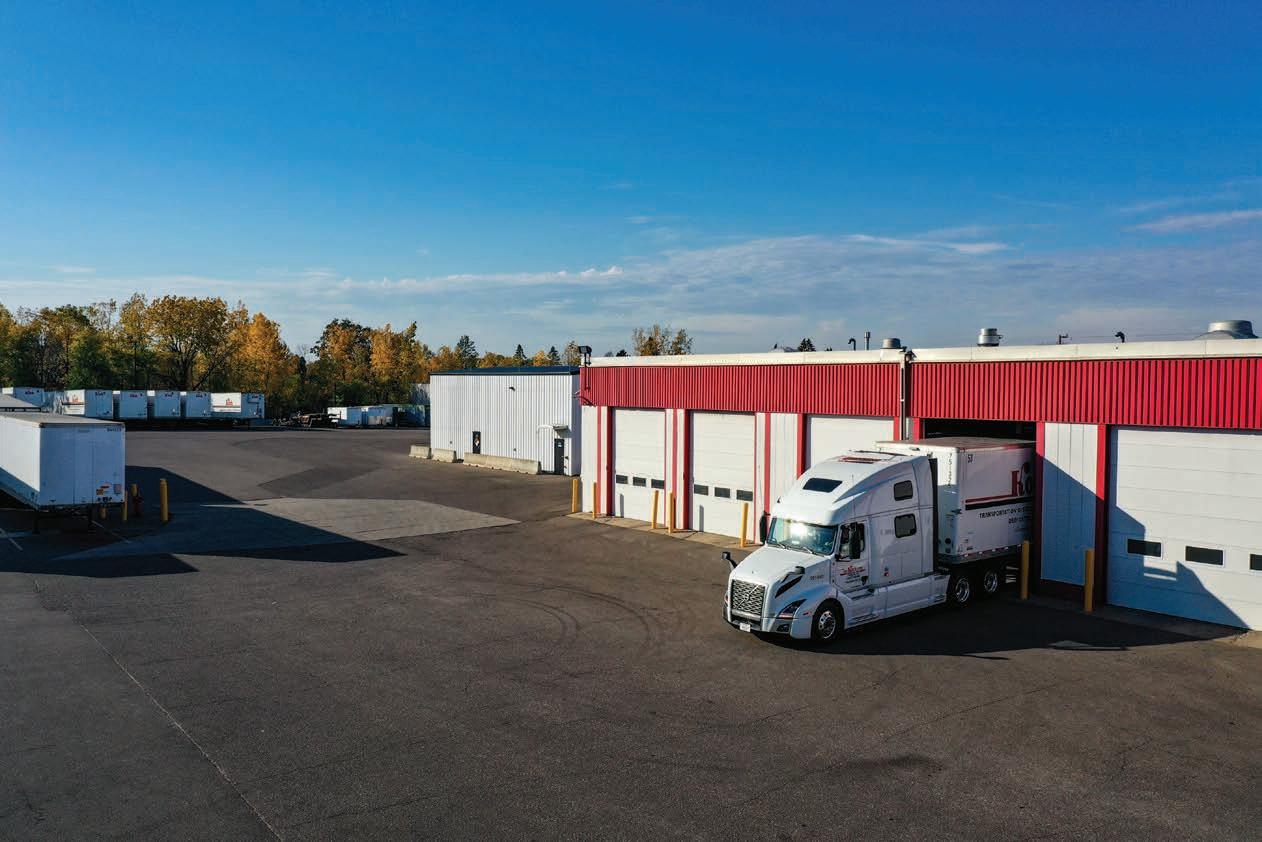
Assess where e-commerce fits into your business strategy. Warehousing capacity is a significant challenge for many food shippers, since demand for space is exacerbated by the need to position products close to consumers for e-commerce fulfillment. In fact, several 2022 Top Food Chain Providers offer fulfillment, warehousing and distribution capabilities as part of their service portfolio – and these areas have become more valuable to shippers (and more profitable). If your need for e-commerce is growing in your business, make sure your provider partners excel in this area.
Ensure your provider partners are investing in technology. Investment banker Stifel reports that some 3PLs now are focusing on changing the game altogether. One significant player relies on technology including cloud-based warehouse management systems (WMS), automated sortation systems, and robots for picking and fulfillment as both a value to its customers and a key to lowering its unit costs (see article on Technology in Warehousing on page 40).








Category: Freight Broker
Website: www.atsvisalia.com
Services: Brokerage, temperature-control
Category: Freight Broker Website: www.burnslogistics.com
Services: Truckload, LTL, Refrigerated, Flatbed, Expedited, HAZMAT, Project Management
Category: Freight Broker Website: www.allenlund.com
Services: Brokerage, Dry, Refrigerated, LTL, Flatbed
Category: Third-Party Logistics Website: www.alliance.com
Services: Temperature-Control, Domestic Intermodal, Highway Capacity, International, Customs Brokerage, Mexico
Category: Freight Broker
Website: www.arrivelogistics.com
Services: LTL, Expedited, Dry Van, TemperatureControl, Dedicated Capacity, Flatbed, Intermodal
Category: Third-Party Logistics
Website: www.bluegracegroup.com
Services: LTL, Truckload, Expedited, International, Air, Ocean, Supply Chain Management, Freight Forwarding, Refrigerated
Category: Motor Carrier and Third-Party Logistics Website: www.cat.ca
Services: Truckload, Global, Crossborder, Dedicated, Intermodal, Drayage, Warehousing
Category: Third-Party Logistics Website: www.capstonelogistics.com
Services: L Freight Management, Warehousing, Fulfillment, Last-Mile Fulfillment
Category: Third-Party Logistics
Website: www.bayandbay.com
Services: Refrigerated Trucking, Dry Tank, Flatbed, Intermodal, Project Management
Category: Third-Party Logistics
Website: www.beckerlogistics.com
Services: Drayage, Drop-Trailer, Dry Van, Expedited, Flatbed, Intermodal, LTL, Refrigerated, White Glove
Category: Motor Carrier Website: www.shipcti.com
Services: Refrigerated Truckload or LTL
Category: Motor Carrier Website: www.ceioh.com
Services: Truckload, Temperature-Control, Dedicated Capacity



Whether the US, Canada, or our Southern border, Kam-Way is uniquely positioned to bring you the best in FTL Freight Brokerage, Freight Forwarding, Dedicated Services and Asset based Solutions.
Your assigned team is available 24/7/365 supporting your commitments and providing timely updates no matter the time of day.

Kam-Way strives to develop a long-lasting partnership with you through honest, forward-thinking collaboration!
Category: Third-Party Logistics Website: www.coyote.com
Services: Truckload, LTL, Intermodal, Air, Ocean
Category: Motor Carrier Website: www.dvlexpress.com
Services: Truckload, LTL, Refrigerated, Drop Trailer, Warehousing
Category: Freight Broker Website: www.echo.com
Services: Truckload, LTL, Intermodal, International Air, Ocean, Small Parcel
Category: Third-Party Logistics Website: www.hubgroup.com
Services: Intermodal, Truck Brokerage, Dedicated, International, Final-Mile, Parcel
Category: Motor Carrier Website: www.flotrans.com
Services: Truckload, LTL, Brokerage, Air Freight, Intermodal
Category: Motor Carrier Website: www.jbhunt.com
Services: Intermodal, Dedicated, Truckload, Final Mile, Fulfillment, LTL, Flatbed, Temperature-Control, International, Expedited
Category: Motor Carrier Website: www.kam-way.com
Services: Brokerage, Forwarding, Dedicated, Temperature-Control
Category: Motor Carrier Website: www.kochcompanies.com
Services: Truckload, Dedicated, Flatbed, Specialized, Brokerage, Ocean, Air, Leasing
Category: Motor Carrier Website: www.ffex.net
Services: LTL, Dedicated, Expedited, Warehousing, Temperature-Control
Category: Third-Party Logistics Website: www.fstlogistics.com
Services: Truckload, Warehousing, E-Commerce Fulfillment, Temperature-Control
Category: Motor Carrier Website: www.kriska.com
Services: Truckload, LTL, Temperature-Control, Intermodal, Warehousing
Category: Motor Carrier Website: www.newlegendinc.com Services: Dedicated, Expedited, Refrigerated, Truckload


Category: Third-Party Logistics
Website: www.odysseylogistics.com
Services: Intermodal, Rail, Specialized, Warehousing, Managed Services, Freight Forwarding
Category: Motor Carrier Website: www.odfl.com
Services: LTL, Expedited, Truckload Brokerage, Container Drayage
Category: Third-Party Provider Website: www.penske.com
Services: Transportation, Warehousing, Freight Management, Dry-Van Truckload
Sethmar Transportation Category: Third-Party Logistics Website: www.sethmar.com Services: Truckload, LTL, Intermodal, Drayage, Warehousing, Consolidation, Expedited
Category: Trailer Leasing Website: www.plmfleet.com
Services: Refrigerated Fleet Leasing, Rental, Maintenance, Technology
Category: Third-Party Provider Website: www.ruan.com
Services: Dedicated, Managed Transportation, Warehousing, Brokerage
Category: Motor Carrier Website: www.sunstatecarriers.com
Services: Truckload, Refrigerated, Flatbed
Category: Freight Broker Website: www.surgetransportation.com Services: Truckload, Van, Refrigerated
Category: Third-Party Logistics Website: www.syfanlogistics.com
Services: Truckload, LTL, Flatbed, Expedited, Temperature-Control, Flatbed
Category: Motor Carrier Website: www.savagesweetsinc.com
Services: Liquid and Dry Bulk, Refrigerated
Category: Material Handling Website: www.raymondcorp.com
Services: Material Handling Products, Intralogistics Solutions, Integrated Automation, Telematics
Category: Third-Party Logistics
Website: www.shipperswarehouse.com
Services: Warehousing, Contract Warehousing, Packaging, E-Commerce, Truckload, LTL, Drayage, Crossdock

The Shippers Group is proud of our role in the supply chains that positively impact lives. Not only do we provide consistent service and deliveries, TSG exceeds BRC global standards for food safety and AIB sanitation ratings. All this allows us to provide a stellar experience to our customers and beyond.
To learn more about
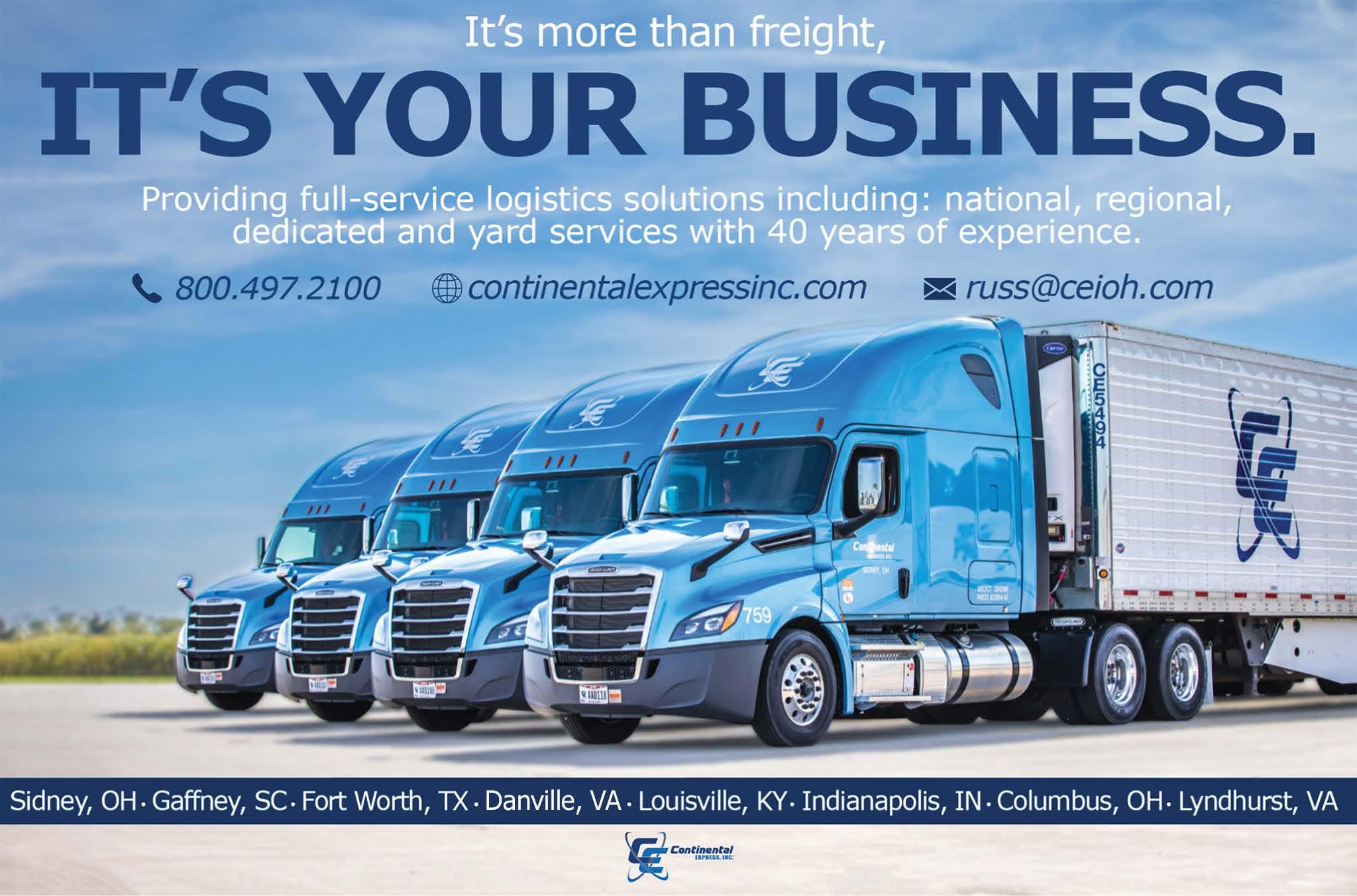
Category: Freight Broker
Website: www.t-insight.com
Services: Domestic Freight, Parcel, Warehousing, Data Intelligence, Supply Chain Consulting
Category: Motor Carrier Website: www.tuckerfreight.com
Services: Dry Van, Freight Transportation, Flatbed, Dedicated, Brokerage
Category: Third-Party Logistics
Website: www.uberfreight.com
Services: LTL, Technology
Category: Motor Carrier
Website: www.werner.com
Services: Dedicated, Truckload, Intermodal, Temperature-Control, Expedited, Logistics, Cross-Border, Final Mile
Category: Third-Party Logistics
Website: www.xtl.com
Services: Warehousing, Distribution, Logistics, Intermodal, Dedicated, Temperature-Control
View the 2022 Top Food Chain Providers online at www.foodshippers.org.
Food Shippers of America gives you access to more market intelligence, best practices, and industry news on critical topics. You’ll find it all through four primary resources:
• FoodShippers.org offers relevant, up-to-the-minute content.
• Food Chain Digest leverages an editorial team with more than 100 years combined experience in transportation, logistics and supply chain.

• Food For Thought features more relevant information, more often.
• Social media channels provide comprehensive information designed specifically for and about food shippers. Make sure to follow us on LinkedIn (corporate page and discussion group), Facebook, Twitter, and Instagram!
Download a 2022 Food Shippers Media Kit at FoodShippers.org or reach out to Cassidy Haley at cassidy@mindshare.bz or 952-442-8850 x215.

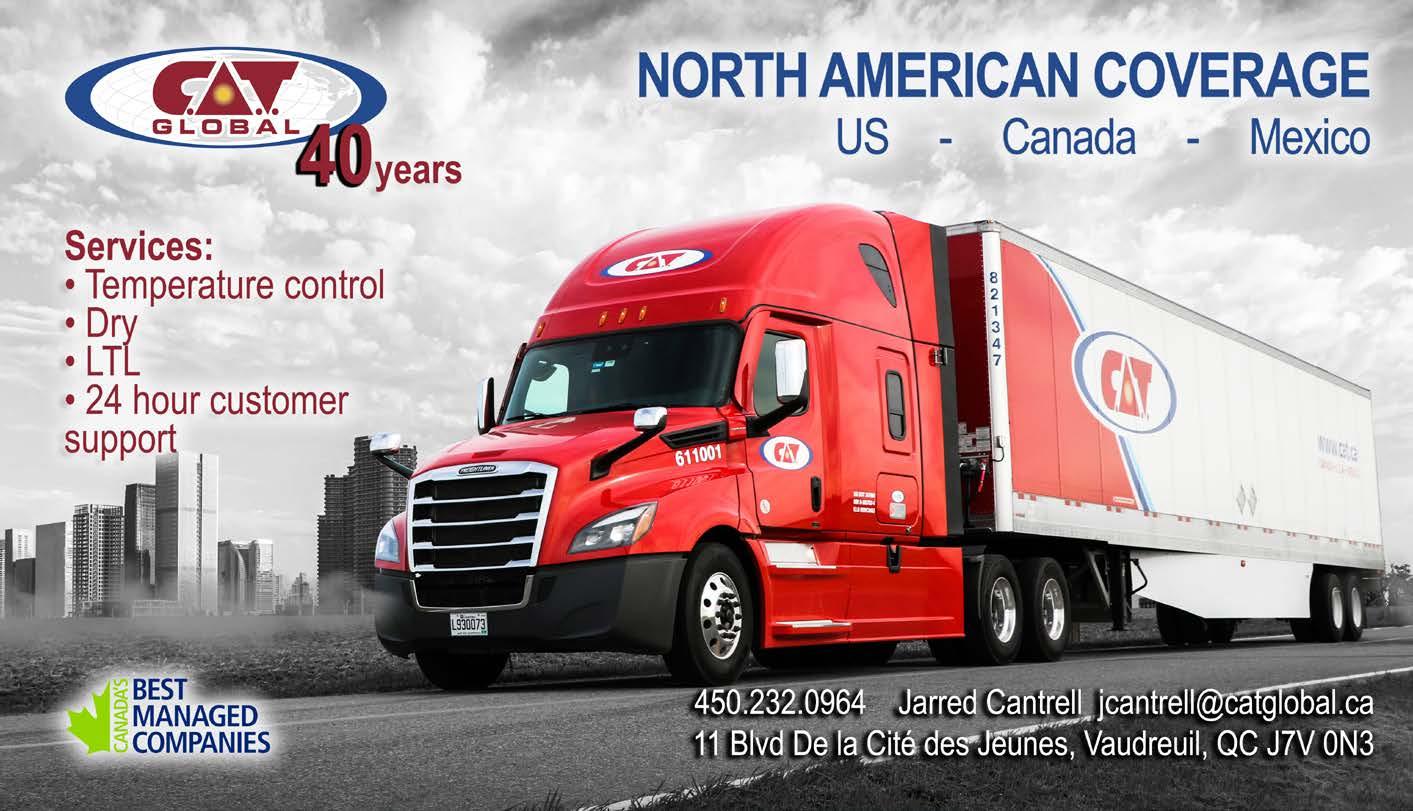



IN
RESPONSIBILITY IS GROWING SIGNIFICANTLY AMONG FOOD SHIPPERS AS THERE IS AN INCREASED FOCUS ON SUSTAINABILITY IN BOTH DOMESTICALLY AND ABROAD.
Greenhouse gas (GHG) emissions have been reported to contribute to climate change and according to the National Oceanic and Atmospheric Administration, over the last decade of the past century temperatures across the global have increased an average of .13°F. Temperatures are projected to increase up to 10.2°F over the next century unless action is taken to reduce harmful emissions.
Food businesses are facing pressure from stakeholders to operate in a more sustainable manner. In fact, nearly two-thirds of businesses responding to the 2020 Gartner Sustainability Survey said they felt pressure from their customers to invest in sustainability initiatives while 48 percent said pressure was coming from investors and 48 percent said they felt pressure from regulators.
According to the MIT Center for Transportation and Logistics’ State of Supply Chain Sustainability report, supply chain sustainability is a moving target as the pandemic put the supply chain in the spotlight. The resulting disruptions required many businesses to assess how they could do things differently.
The Annual State of Logistics Report from the Council of Supply Chain Management Professionals (CSCMP) concluded that companies commitment to resilience also will incorporate sustainability both as a way of addressing the needs of customers and a way to control fuel costs.
Many states have mandatory GHG emissions reporting requirements, and the EPA has developed the GHG Protocol Corporate Standard which categories GHG emissions associated with a company’s
carbon footprint. The standard categorizes emissions as follows:
• Scope 1 (“direct emissions” created from a company’s owned or controlled sources.
• Scope 2 (“indirect emissions” from purchased or acquired energy such as electricity that is purchased from a utility that generates the emissions but the purchaser indirectly u the emissions.
• Scope 3 (“indirect value chain emissions” defined by the EPA as emissions that are the “result of activities from assets not owned or controlled by the reporting organization, but that the organization indirectly impacts in its value chain”). Transportation and distribution fall into this category.
The CSCMP report analysis said this “has raised the bar for actual achievement of sustainability goals.”
Given the pervasiveness of GHG emissions, it is going to require collaboration throughout the entire supply chain for food shippers to reach their sustainability goals. Shippers will need to rely on their partners if they hope to make significant progress toward achieving meaningful sustainability goals.
“To stay ahead of ever-accelerating supply chain and customer demand, food and beverage operations need solutions that are connected and scalable,” says Damon Hosmer, Product Marketing Manager, Energy Storage Technology & Integration at The Raymond Corporation.
This is especially true given that, according to the MIT research, “People are looking to only
purchase from companies that are investing in sustainability and are committed to being leaders in the space.”
CSCMP believes the biggest carbon reduction opportunities can only pursued via shippers and carriers working together. The report says, “Logistics is all about helping different entities collaborate toward fulfillment of shared goals, so this boundary-bending, we’rein-this-together approach to sustainability is a natural for the sector.”
The association also believes that in time shippers will be able to use science-backed tracking of the Scope 3 emissions “to quantitatively assess suppliers’ sustainability practices and to choose partners whose aspirations align with their own.”
The good news for food shippers is that fleets are taking action to operate more sustainably.
TravelCenters of America Inc. recently completed a Sustainable Fuel in Trucking: The Greening Of America’s Trucking Industry survey. It found that nearly one-third of the fleets responding to the survey have already adopted sustainability or net-zero emissions goals.
Food shippers need to be aware that fleets have a variety of options when it comes to operating cleaner trucks, including compressed natural gas, renewable natural gas, biodiesel, renewable diesel, battery electric power and hydrogen fuel cell power. However, fleets are showing a great deal of interest in battery electric vehicles, with half the companies responding to the survey indicating they expect to have electric vehicles in their fleets by 2030. Most of the companies responding to the survey anticipate
CSCMP BELIEVES THE BIGGEST CARBON REDUCTION OPPORTUNITIES CAN ONLY PURSUED VIA SHIPPERS AND CARRIERS WORKING TOGETHER.
that battery electric trucks will make up 11 percent to 25 percent of their fleets by 2030. Currently only 5 percent of the fleets responding to the survey have hydrogen vehicles today but that number will likely increase to nearly 25 percent of fleets by 2030.
Food shippers are advised not to ignore the sustainability issue. Doing so could cause them to lose their competitive advantage and even lose out on new business as more and more companies are placing increased emphasis on meeting sustainability goals. Now is the time for food shippers to start questioning their supply chain partners about their sustainability efforts in order to find the right partners for the future.
Working with their supply chain partners to achieve GHG reductions is good for the environment and a smart business decision.
According to Jeff Jackson, Executive Vice President Operations, Dedicated Contract Carriage, Penske Logistics, a Penske Transportation Solutions Company, “Penske Transportation Solutions is always striving to

find solutions for our customers’ transportation needs, and as of late, that has included employing electric trucks.”
He says the company works to spec vehicles to efficiently do the work its customers need and is constantly optimizing customer logistics networks and continually improving maintenance practices to ensure equipment is operating at peak efficiency. The company uses technology to analyze, identify and implement improvement opportunities that lend themselves to sustainable transportation solutions.
Jackson says Penske is a market leader with the use of light-, medium- and heavy-duty electric trucks. In its logistics fleets Penske is running a select amount of heavyduty electric vehicle in California on behalf of its customers. The company also is working with truck makers to pilot electric trucks in other applications.
In addition, Penske is active with the U.S. EPA SmartWay program and enrolls its customers in the measurement program.
He says the company “understands that food shippers place a high value on consistent and on-time delivery of their products. With
Penske Logistics, they get high uptime with sustainable transportation solutions. If there is a sustainable transportation solution that a current or prospective customer is interested in incorporating into their fleets, we have the equipment, knowledge and support to make that a reality.”
The Raymond Corp. says that it works to minimize its direct and indirect impacts on the environment through a variety of initiatives.
According to Damon Hosmer, Product Marketing Manager, Energy Storage Technology & Integration at The Raymond Corporation, “Our century-long history of innovation, quality and service naturally led to us incorporating environmental considerations into the design process for the life cycle of our products.”
In partnership with Binghamton University faculty and New York State Energy Research and Development Authority, the company developed a new energy storage process that will turn warehouses into controllable energy hubs that can be optimized
“PENSKE TRANSPORTATION SOLUTIONS IS ALWAYS STRIVING TO FIND SOLUTIONS FOR OUR CUSTOMERS’ TRANSPORTATION
NEEDS, AND AS OF LATE, THAT HAS INCLUDED EMPLOYING ELECTRIC TRUCKS.”
- JEFF JACKSON, PENSKE TRANSPORTATION SOLUTIONS
Founded in1977,Alliance ShippersInc.has grown to become one of the largest privatelyowned global logistics and transportation service corporations.Today,the Alliance Team links several different divisions with the best people, technology and service for our customers.
At Alliance Shippers Inc., we dedicate ourselves to continuously improving our services withThe Perfect Shipment.® It’s our company-wide commitment to the following four goals:

• arrange for on-time pickup of the shipment
• arrange for delivery of the shipment at the time requested
• assist for delivery of the shipment without exception
• provide an accurate freight bill
With more than 40 years of commitment to excellence, you can rely on us to arrange the right solution for your logistics and supply chain needs.
No matter what you’re shipping, where it’s going or how it’s getting there, our commitment to you is the same as it was when we beganThe Perfect Shipment® program in1992.
to supplement the power grid during normal and peak operations. “We also work to provide our customers with energy solutions and material handling equipment that is environmentally conscious. Our equipment is designed, engineered and manufactured for eco-performance to help lower energy costs, reduce carbon footprints, enhance productivity and throughput, while still providing unmatched durability and reliability at a lower cost,” he says.
Regarding its work with food shippers, Hosmer says, “We help operations anticipate increased demand by providing innovative intralogistics solutions that drive effectiveness through the optimization of people and processes.” The company offers a full line of forklift batteries, chargers and battery handling systems.
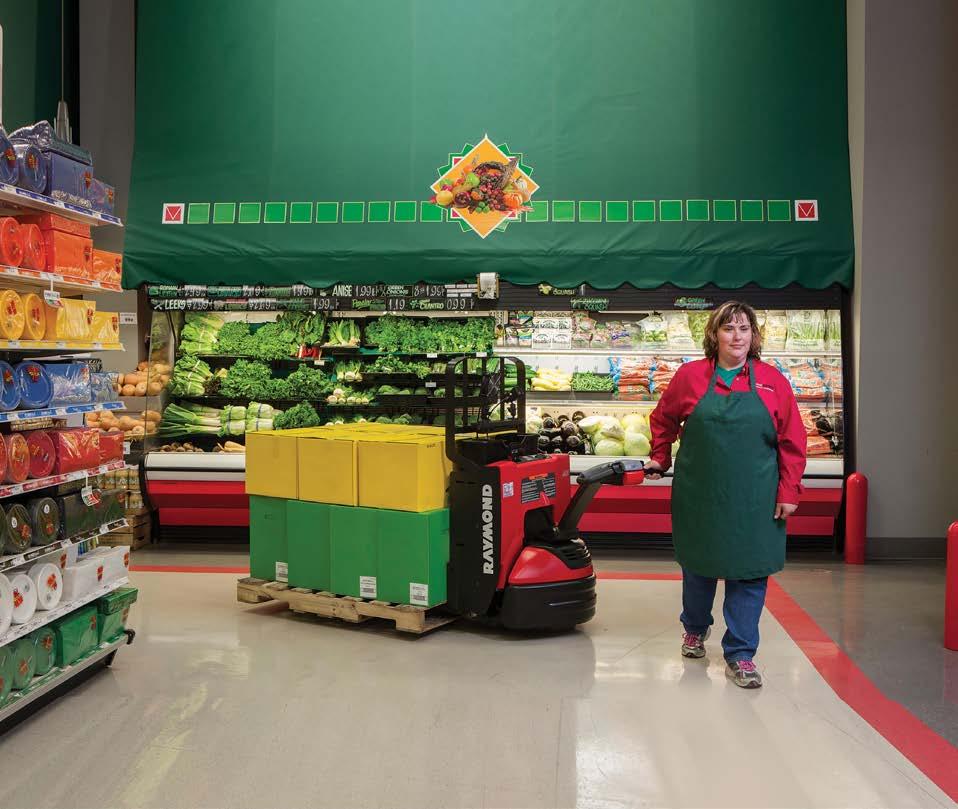
“As a single-source energy solutions partner, we provide service and support across our customers’ entire portfolio of energy solutions to identify, integrate and optimize the right energy management and control
systems for their unique needs,” he adds.
“We recognize our responsibility to be a good steward of the environment and contribute to a more sustainable planet. We strive to reduce our impact, and that of our customers, on the environment,” he concludes.
More than 10 years ago, the Temperature Control Division of Alliance Shippers switched to Carrier’s Vector refrigeration units as a way to save fuel but also found additional benefits. Ed Wright, Vice President of the Temperature Control Division of Alliance Shippers, explains that for every gallon of fuel a refrigeration unit burns, it produces approximately 22.2 lbs. of CO2. “As we looked at more efficient refrigeration units, we also realized that there was an impact on the environment.”
The Temperature Control Division moves the majority of its freight by rail and found that the CO2 output of a shipment moved via
rail vs moved with a truck yielded anywhere from 55 percent to 64 percent less CO2. In fact, as a SmartWay participant/provider since 2006, Alliance Shippers continuously works on methods that improve fuel deficiencies within its ALLZ fleet. It’s CARBcompliant refrigeration fleet has the most current technology to move products with reduced CO2 emissions by approximately 67 percent via the nation’s railways.
Alliance takes a consultant’s role with its customers and helps them find ways to further reduce their CO2 emissions. One example was using geofencing to adjust temperatures during shipping to account for the impact of the product expanding at high elevation. This resulted in a 20 percent reduction in CO2. Another was convincing a client that its product that was at 0°F when loaded did not need to be hauled at -20°F and that setting the refrigeration unit at the higher temperature resulted in less fuel being used and reduced CO2 emissions.
“When we put a proposal together, we put together our operations plan, our pricing strategy and plan and then we tell them what the CO2 reduction will be using intermodal.”
As a global leader in chemical and ingredient distribution, Univar Solutions takes its environmental, social, and governance (ESG) responsibilities seriously. The company is implementing technology, processes, and culture to support its sustainability goals: to reach 20 percent absolute reduction in CO2e emissions by 2025, 40 percent by 2030, and to achieve net-zero direct emissions by 2050. One of the ways the company is making a difference is by implementing electric trucks.
A state-of-the-art temperature-controlled facility just 30 minutes from Atlanta is all about addressing our customers’ needs.

It’s more sustainable - our customer has production capabilities attached, so less transportation is required. It’s ready for the new labor market - we removed many of the manual tasks – ones that can be repetitive, labor intensive, and more costly. There are less touches - we connected everything with automatic conveyors, elevators, and cranes.
We always strive to give our customers the best solutions, the best advantages, and the best in cold.

We've seen a l ot i n the l ast 80 -pl us years, ex cept for maybe the asteroi ds, but w e'l l keep on trucki ng. It's i n our bl ood.
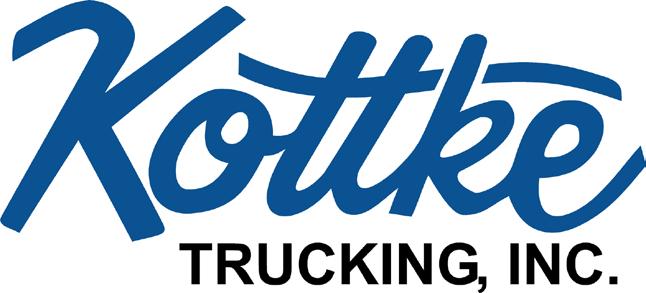










There is an unending list of disruptors that have had a direct (or indirect) impact on food chains over the last few years. They can be economic drivers such as volatile fuel prices and Brexit, or business disruptors such as the Great Resignation, capacity and rates. Or they can be geopolitical drivers such as the Russian invasion of Ukrane, or natural disasters such as the record-breaking hurricane season of 2020 or the recent Japan 7.3 earthquake.
While food chain leaders invest significant time, effort and dollars to assess and mitigate known threats, they cannot predict every threat in advance. That’s why the traditional action plan for these unforeseen scenarios that involves responding to each one in turn and building resilience through backup suppliers or increased inventories is no longer adequate.
Another step is necessary: Food companies must reduce the number of disruptions they experience in the first place.
More and more food shippers are reducing their overall exposure by reducing risk events. To some, this may sound difficult to do (or perhaps even impossible), but a select few have done this, according to a recent survey of 262 supply chain leaders recently conducted by Gartner. In fact, those shippers who are successful at reducing risk events undergo less than one-third of the disruptions that others do.
The broad advice from professionals in this survey: Make your supply chain a smaller target by reducing your physical footprint (e.g., number of suppliers, number of manufacturing sites) and the movement within it (e.g., fewer processes, fewer shipping lanes) to reduce your overall exposure. While you cannot control the number of risk events that occur, you can influence how many affect your company. How? Cut them out of your supply chain before they hit However, there is of course a limit to making your supply chain a smaller target. Extreme consolidation will expose your organization to single catastrophic event, so finding the right balance for your unique supply chain is critical.
Food companies that make themselves a smaller target, compared with those responding piecemeal to challenging situations, can shape the rate of disruptions they experience (see “Effect on Rate Disruptions” below).
Both types of companies pursue the same strategic objectives: managing risk, optimizing costs, innovating constantly and meeting customer expectations. However, the way they go about it is what’s different — along with the end results.
Extremely easy target for the risk environment to disrupt Harder target for the risk environment to disrupt
THE BROAD ADVICE FROM PROFESSIONALS IN THIS SURVEY: MAKE YOUR SUPPLY CHAIN A SMALLER TARGET BY REDUCING YOUR PHYSICAL FOOTPRINT (E.G., NUMBER OF SUPPLIERS, NUMBER OF MANUFACTURING SITES) AND THE MOVEMENT WITHIN IT (E.G., FEWER PROCESSES, FEWER SHIPPING LANES) TO REDUCE YOUR OVERALL EXPOSURE.
There are two ways to make your food chain a smaller target:
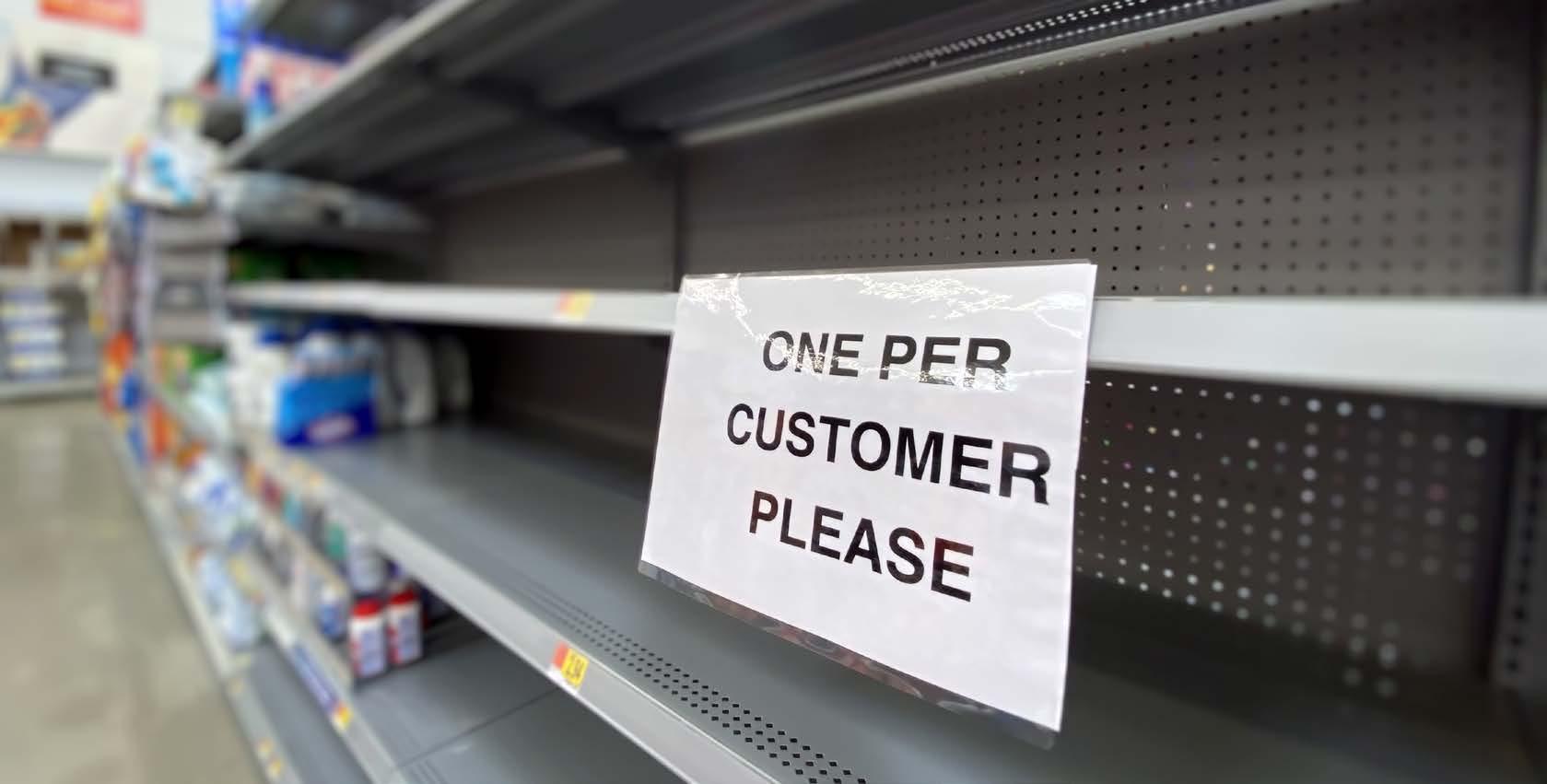
• Prioritize changes based on your competitors’ vulnerabilities to give your business the competitive advantage.
• Put limits in place to avoid too much expansion when you diversify your risk exposure.

It’s not always clear where to start making your supply chain a smaller target. You can concentrate on so many parts of your food chain — from suppliers to processes to locations. Some ways to you can assess opportunities is to conduct competitive reviews of what other companies are doing, speak with industry subject matter experts, and review relevant data about future risk trends - such as the rising demand for customization or the industry reliance on a single region for a particular commodity.
Such disruptors have had a significant impact for manufacturers, retailers and distributors of food and beverage products – and General Mills is no exception. The American multinational manufacturer and marketer of branded consumer foods has been navigating through major disruptors for the past two-plus years, said Jonathon J. Nudi, General Mills, Group Vice President, North American Retail at the recent RBC Capital Markets Consumer and Retail Conference.
“We’re seeing 10 times the number of disruptions in our supply chain from an ingredient standpoint
coming into our plans than we ever experienced before,” Nudi said. “And this gets really challenging because we can’t see them coming in many cases. So a truck is supposed to show up with oil at our refrigerated dough plant in Tennessee and doesn’t show up. So we have to shut the line down. Obviously, that creates lots of issues in terms of having the right amount of product and supply to our customers. And at the same time, it drives a lot of incremental costs as well. So we have thousands of these material disruptions every single month now, and it’s something that we haven’t seen before.”
A tight labor market has been a longstanding issue, compounded by COVID, which precipitated global supply chain problems, Nudi continued. In addition, the subsequent war in Ukraine and resultant material disruptions have
"WE’RE SEEING 10 TIMES THE NUMBER OF DISRUPTIONS IN OUR SUPPLY CHAIN FROM AN INGREDIENT STANDPOINT COMING INTO OUR PLANS THAN WE EVER EXPERIENCED BEFORE.” - JONATHAN NUDI, GENERAL MILLS
PALLETTR A DER.COM—
PALLETS ARE REMARKABLE FEATS OF ENGINEERING, THEY CAN MOVE EVERYTHING BUT THEMSELVES. THAT’S ABOUT TO CHANGE.

JOIN THE PALLETTRADER COMMUNITY TODAY. REGISTER AT PALLETTRADER.COM

POWERED BY BETTAWAY
ENTER CODE REINVENT AT CHECKOUT FOR 6 MONTHS FREE
created unprecedented challenges. But challenges aren’t just involving availability of the manufacturer’s principal ingredient of grain, as 90 percent of the company’s grain supply is sourced in North America, he said “We have the ingredients that we need,” said Nudi. “It’s really price, and it’s a global grain market. So we’ve been impacted by that... Starch, frankly, it’s something I didn’t realize what we use in so many different products. It’s really used as a processing aid and starch has been constrained for more than a year now, and that’s been a real challenge for us. Oil, a little bit of knock-on impact of
what’s happening in Ukraine has become a challenge from a supply standpoint. Even beyond that, again, I’m learning all kinds of things I didn’t know, but oil has to ship in specific trucks that are built for shipping oil and have drivers that are specifically trained to drive this truck. There’s a shortage of those truckers right now.”
Nudi has a weekly “control tower meeting” where he meets with his team on the most significant issues and collaborates to break down barriers and find solutions. “So trying to build resiliency back in the supply chain will help us from a sales standpoint as well actually being better in stock levels, and at

the same time, hopefully take out some costs over time as all these disruptions are very costly as well,” he said.

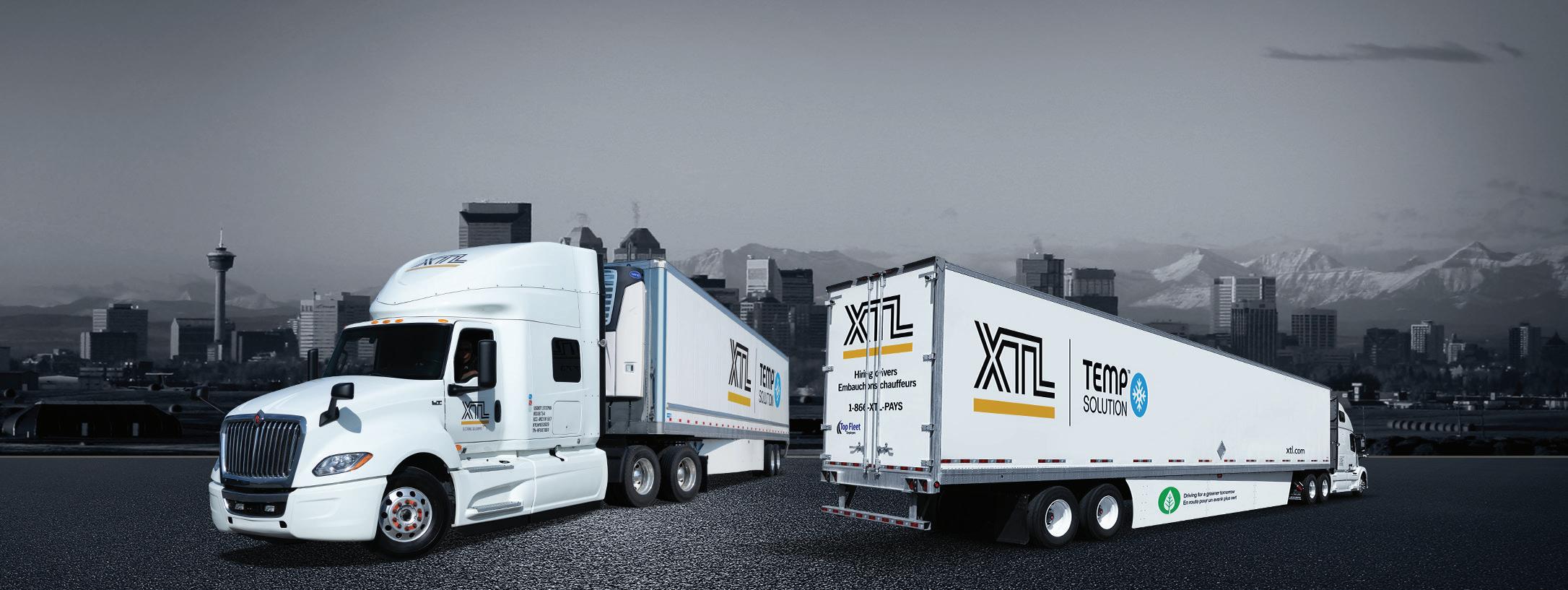
The war in Ukraine has pressured supplies of essential ingredients in food products, particularly wheat and cooking oils. In 202021, Ukraine was responsible for 31 percent of global sunflower oil exports, while Russia and Ukraine combined accounted for 28 percent of wheat production, according to the U.S. Department of Agriculture.
As a consequence, other food companies such as Conagra Brands and Mondelēz International are
THE WAR IN UKRAINE HAS PRESSURED SUPPLIES OF ESSENTIAL INGREDIENTS IN FOOD PRODUCTS, PARTICULARLY WHEAT AND COOKING OILS.






 Coldliner is Recognized as One of the Leading Asset Based Transportation Providers, with Unmatched
Coldliner is Recognized as One of the Leading Asset Based Transportation Providers, with Unmatched
challenged with production hiccups as factories are forced to wait for the arrival of key ingredients.
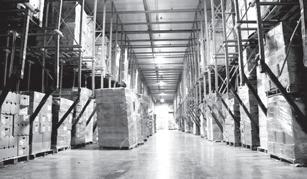
“Unfortunately, you can’t make a Twinkie with only 95 percent of ingredients,” said Hostess Brands CFO Travis Leonard on a shareholder call in early August, noting that ingredients shortages have created production scheduling challenges and transportation inefficiencies.
Conagra, producer of Marie Callender’s and other frozen food brands, experienced a volume drop of 6.4 percent over the previous quarter as ingredient constraints had an impact on the production of refrigerated goods. The business has also seen higher-thanexpected inflation for edible oils.
“If we’re missing an ingredient, we can’t produce,” said Conagra’s Chief Financial Officer Dave Marberger during a July call.


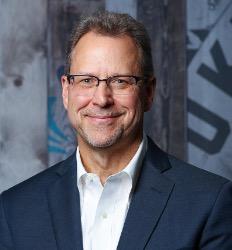
Snack maker Mondelēz recently raised prices again to offset inflation from materials, including edible oils and wheat, according to CEO Dirk Van de Put during a recent Q2 earnings call. Supply chain constraints have limited production of biscuits, including for brands such as Nilla, Nutter Butter and belVita. In addition, during a June investors conference, CFO Luca Zaramella noted that the company has experienced some availability issues with oils and grains in particular, and the company is working to reformulate products to “replace some ingredients and components that are in shortage.”
While food shippers continue to navigate these disruptions, those who make their food chains a smaller target will successfully reduce the impact these disruptions can have on their businesses.



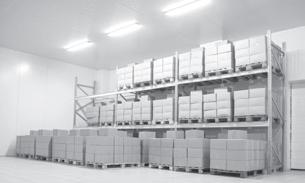

“UNFORTUNATELY, YOU CAN’T MAKE A TWINKIE WITH ONLY 95 PERCENT OF INGREDIENTS.” - TRAVIS LEONARD, HOSTESS BRANDS
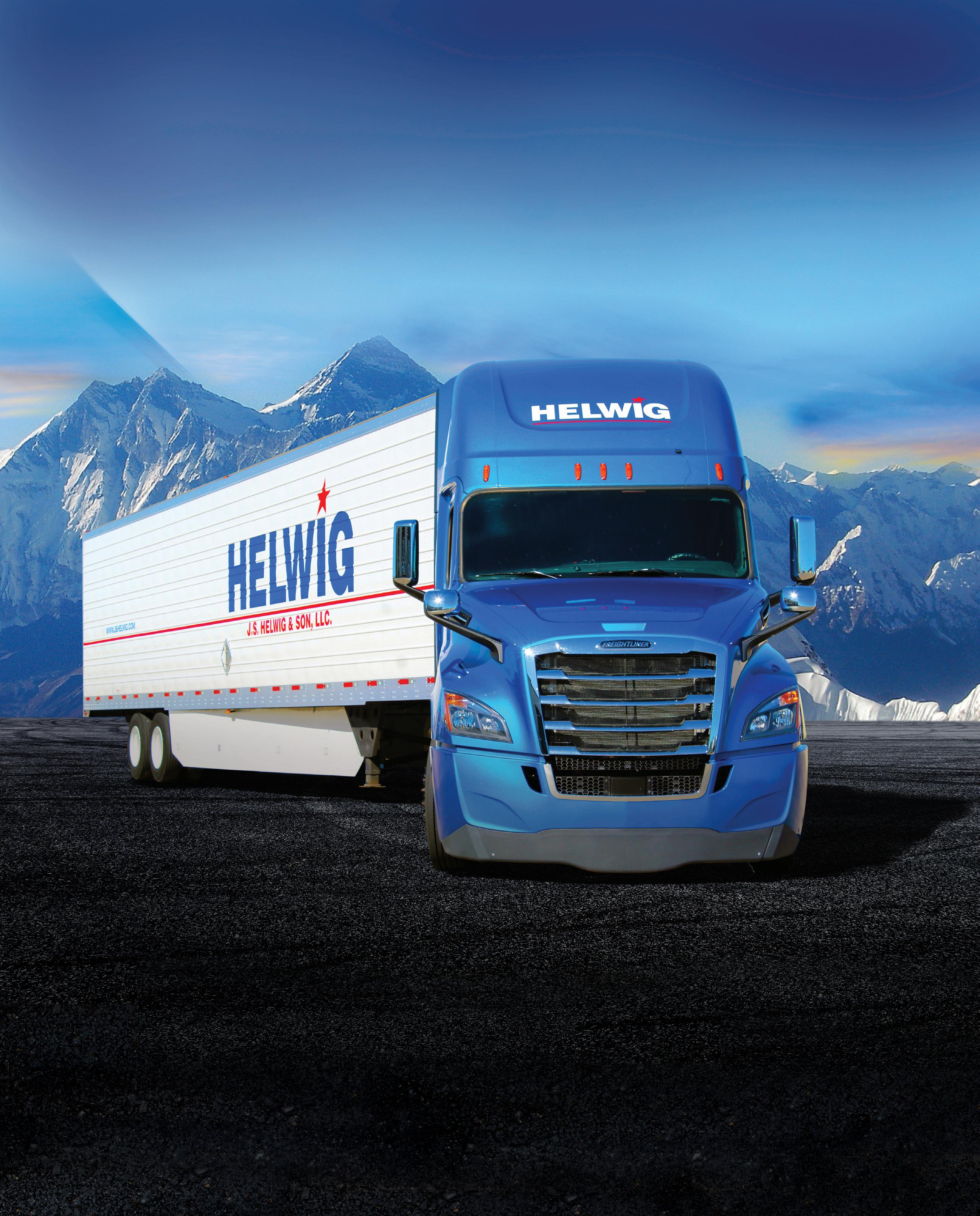

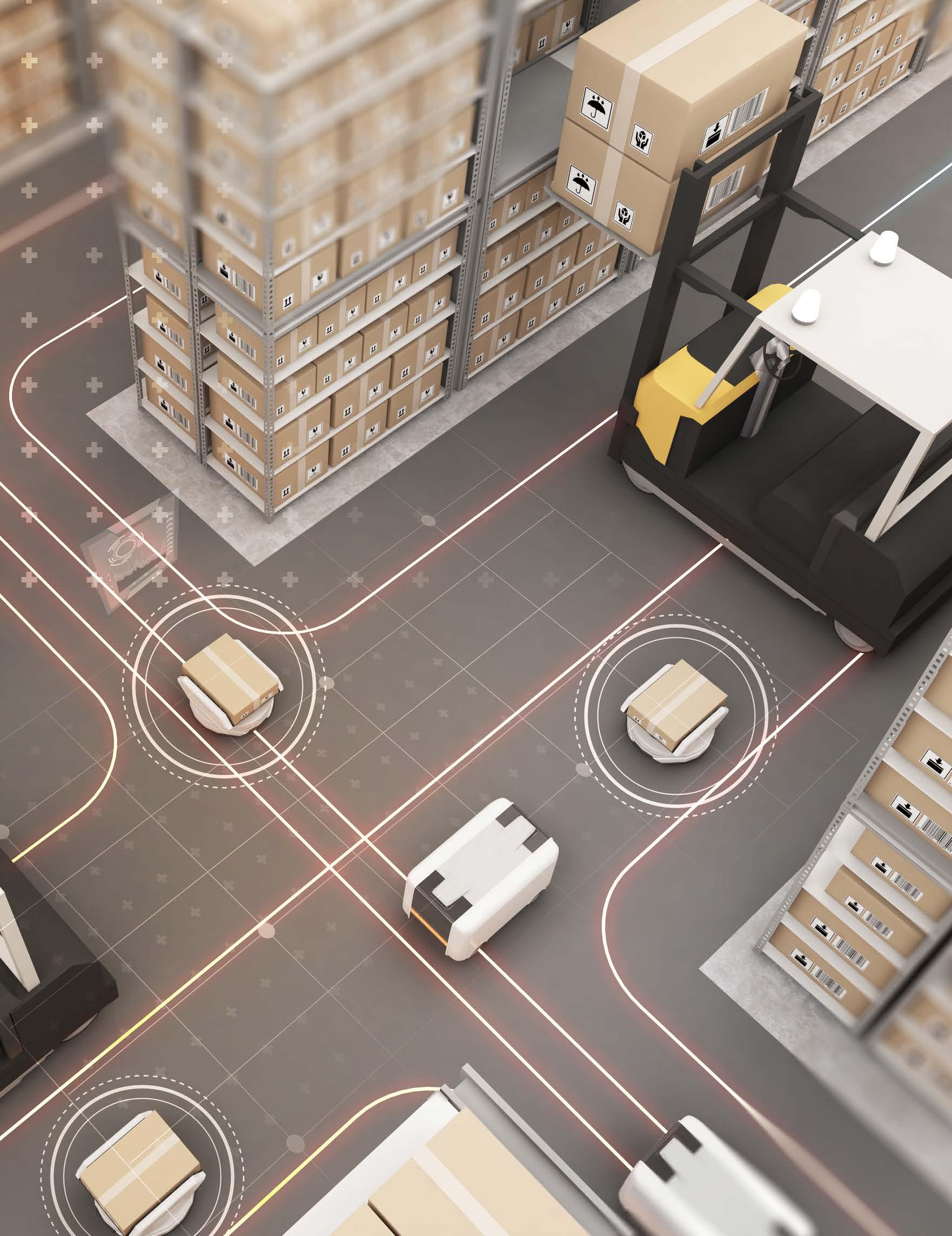
Warehouse and distribution operators continue to work through supply chain woes as well as dealing with an ongoing labor shortage. In response, turning to robotics and automation is becoming more of a norm for companies. Some experts in the warehousing field are hoping for more market-ready solutions to hit the ground so they can make what seems to be a necessary transition from traditional warehouse operations to using more robotics and automation.
Georgia-based US Cold Storage Senior Vice President Regional Manager David Butterfield says he has seen an increase in customer involvement with order patterns, case quality improvements that work in automation, consistency in order patterns to level load warehouse production to automation capacities, and more efficient driver and carrier turn times. He says companies like US Cold are creating, hiring, and training employees for a new skill set linked to automated positions versus the traditional warehouse positions.
Justin Kukal, Senior Director of Automation Engineering for Vertical Cold Storage, says advances in automation have increased the focus on reliability and time to recovery instead of on only rate targets when transporting loads.

“Automated systems have been deployed in warehouse environments for decades now,” Kukal says. “The major difference between the machines of old and new is a significant improvement in controls and internal components that drive reliability.”
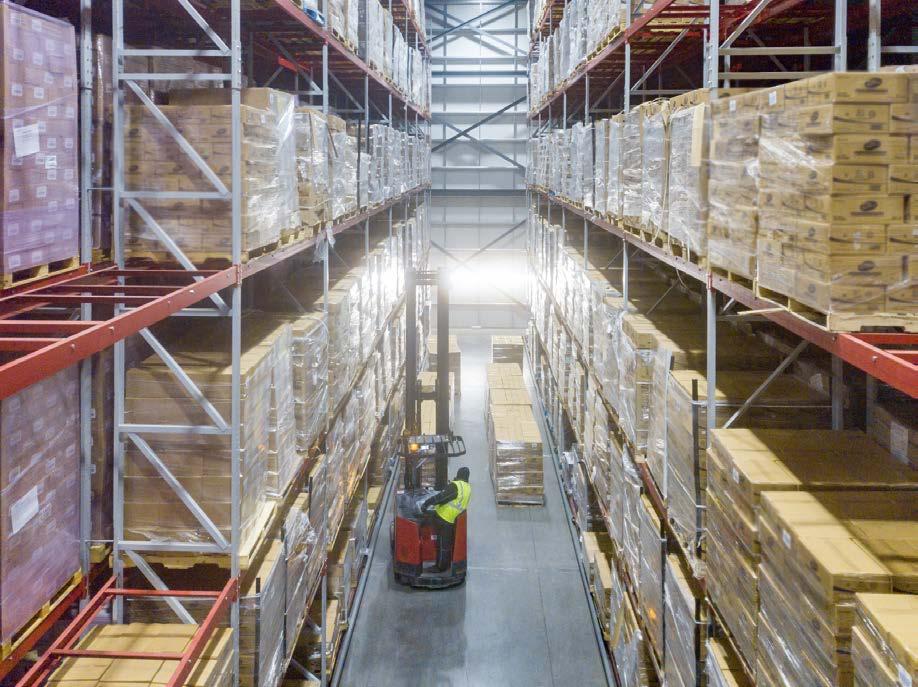
Kukal says Internet of Things (IoT) has been a buzzword for only a few years and is already seen as an industry standard.
“The benefits of interconnected technology and information for operations has been a game changer in our industry,” he says.
“The ability to quickly access in
real-time what is happening on your dock to drive quicker operation decisions has alleviated multiple choke points in the warehouse, thus increasing overall production.”
Kukal says the phrase “work smarter, not harder” is a term that has, and will continue, to pay off across the industry with further advancements from automation and IoT efforts.

how RLS can propel your company forward!
For over 50 years, customers have trusted RLS to manage their complicated frozen and refrigerated supply chains.


We offer flexible and custom-tailored solutions nationwide!
anello® is our powerful business intelligence software. We created a single-source platform that connects our customers with data about every aspect of their transportation and warehousing activities.

Through our BI programming, customers can customize their transportation & warehouse data
Within anello®, customers are provided transparency into their shipment details, vital KPIs and have document retrieval abilities
“A.I. decision making based on realtime information in a warehouse execution system is developing well and will further disrupt our industry,” he says.
Consistency in task performance including the elimination of breaks, lunches, and vacation time is a big factor in how robotics are benefiting warehouses today, Butterfield says. He considers the increase in safety to be another major benefit, with fewer bodies on the floor needing to complete manual tasks. Power savings have also been realized due to the elimination of temperature infiltration.
Kukal agrees that worker safety, mitigating labor demand, increase in productivity, and decrease in
damage are just a few highlights of robotics helping warehouse operations.

“There are multiple benefits, some of which are easily spotted but hard to quantify,” he says. “I believe as more and more tasks get automated, unexpected new benefits reveal themselves.”
Some automated tasks are unnecessary, according to Kukal. “There are very complex automated warehouse designs in our industry today that are not working as intended,” he says. “This is mostly due to an ambition to be on the cutting edge of technology or at least be able to state that in marketing material. A worthy goal, but the other side of the coin is that with these ‘not working
as intended’ projects comes a bad reputation for automation in general.”
Kukal says overestimated ideas for warehouse robotics make it difficult
One of the biggest facilities in the United States Cold Storage (USCS) network just became bigger-and better through automation. The 25-year-old operations in Minooka, Ill., now spans 22 million cubic feet and houses both an automated storage and retrieval system (AS/RS) as well as automated layer picking technology.
USCS’ automated expansion features a 100-foot automated high bay storage building fitted with 13 stacker cranes – directed by the operations warehouse management software (WMS) to automatically store and retrieve pallets from 26,000 pallet positions in two-deep racking that’s eight positions high.

The operation also recently began operating two gantry-style layer picking robots. Using order information, the system can send customer product to the layer picking robots to pick less than full-pallet quantities. The layer picker can create multi-layer, multi-SKU shippable pallets without human intervention.


Lansdale has helped us to grow
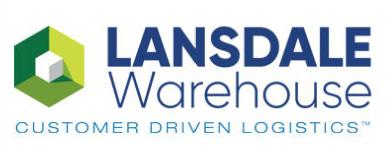
local business, with excellent shipping and delivery procedures.
The staff is knowledgable and accessible by email and by phone.
Our inventory of merchandise is maintained at the highest standards.
Dave

Butterfield says cost and timing are two of the biggest challenges food companies face when considering a transition of traditional operations to include more robotics and automation. He says depending on the scope of the automation, projects can be three to five times the cost of traditional warehouse construction. And, those projects can take 20 or more months to complete. He says hiring and training offer a lot of new skill sets and positions in a warehouse, but far fewer positions than required in a conventional warehouse.”
He says when pitching to company leadership, promote sustainability in servicing customers long term as a major benefit from making the transition.
“Labor has been and continues to be a challenge to fill traditional positions in frozen environments,” Butterfield says. “Automated solutions offer the ability to ship and receive product with 60+ percent less labor. Power savings, less land needed to purchase due to building height…the ability to put 2-3 times more pallet positions on the same footprint, reduction of injuries, and faster more reliable carrier turn times all aid in making the industry better and sustainable for the future.”


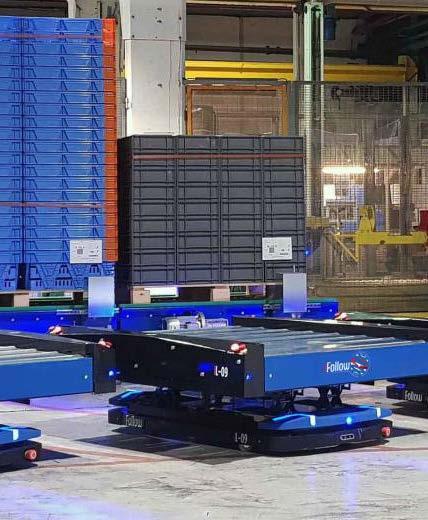
According to Kukal, companies no longer have a choice but to make the transition to more automated warehouse operations.
“The move to automation is going to be a make-orbreak decision for multitudes of companies operating in our industry today,” Kukal says. “Most company leadership knows this and getting buy-in from Senior/C suite leadership is not difficult…as long as your ROI makes sense.”
Kukal and Butterfield both want to see more reliable solutions get to the market quicker. Kukal says he looks forward to mobile case picking, lumping, unloading, and loading technology catching up to the rest of the warehouse technologies that exist today.

Our fleet of refrigerated trailers can handle your frozen and refrigerated freight at the temperature you need. State-of-the-art refrigerated trailers. Rest assured your load will be delivered by the safest, best maintained and modern equipment in the industry.


A significant number of market challenges are creating inefficiencies in supply chains and giving food shippers major headaches: a weak economy, rising inflation, volatile fuel prices, the driver shortage, and port congestion, to name a few. In particular, shortages in these areas are presenting significant challenges to those in the food industry:
Labor Shortages. The Great Resignation has created a major vacuum in the workforce, and ultimately is creating volatile supply and demand in the food chain – from manufacturing and supply chain to logistics, warehousing and transportation.
Truck and Railcar Shortages. Freight shipping delays, lower truck production, a severe shortage in truck drivers and available crews in rail yards are all factors creating a significant void in capacity.
Ports Unable to Unload. North American ports are clogged with containerships as importers jockey for spots in ports in the United States and Canada –ultimately hitting deficits in all operations.
Increasing Transportation and Fuel Costs. Historically approximately one-third of all supply chain costs involve transportation. A faltering global economy is exponentially increasing transportation-related costs.
With these shortages in mind, it’s now critical that food shippers and their partners maximize the capacity and productivity of their trailers or containers – whether it directly involves their private fleets or equipment they’re using through their for-hire carriers.
How big is the problem of unused capacity? For example, recent estimates typically place empty miles around 20 percent, but for the most familiar type of interstate freight – heavy trucks with box trailers or containers - empty miles are substantially higher, says Charles Kiolbasa, Chief Executive Officer of CCT Shipping Frames. “And while unused capacity in partially unfilled trailers or containers are not closely monitored, there’s clearly a significant opportunity
warehouses
to increase efficiencies and save on transportation costs if more concentrated efforts were placed on full space utilization,” says Kiolbasa.
Because let’s face it: Unused capacity over-the-road, on rail, or over the ocean can lead to inefficiencies and higher costs –as well as more damage to products and materials in-transit due to extra shifting.
Another opportunity to increase productivity is to proactively stage freight in the dock area to minimize dwell time, says Kiolbasa: “When you do this, you can ‘load and go’ and get the driver quickly on their way.”
Kiolbasa recommends that shippers and their providers be more proactive and strategic in “building their shipments” and staging their freight. He says there are opportunities to accomplish this in several areas:
• Engage the appropriate operations, sales and customer service teams to collaborate on creating efficient sales and fulfillment processes
• Invest in the right order fulfillment and load planning software to effectively manage the entire order process
• Lastly, invest in technologies and equipment that maximize your trailer and capacity. For example, CCT Shipping Frames manufactures a patented shipping frame that maximizes freight efficiencies in a trailer or container and helps to minimize damage while loading, unloading, and in-transit. “Companies involved in the food chain – whether they be food shippers, carriers or providers –must look at ways to maximize truck productivity in this world of shortages.” For more information, visit www.CCTShippingFrames.com or call 630-441-7046.

CCT’S Load Saver™ Shipping Frame allows you to stack and “cube out” your freight while protecting it from damage. Using a patented 2-deck frame design that’s sturdy and safe, this unique product can be customized to meet any shipping challenges you have.


Flexible and customized to individual challenges Purchase or rental options available
Holds up to 4,000 lbs. (truck version) and 8,000 lbs. (rail version)


Maximize use of your trailers or containers and reduce damage risk
ShippingFrames.com
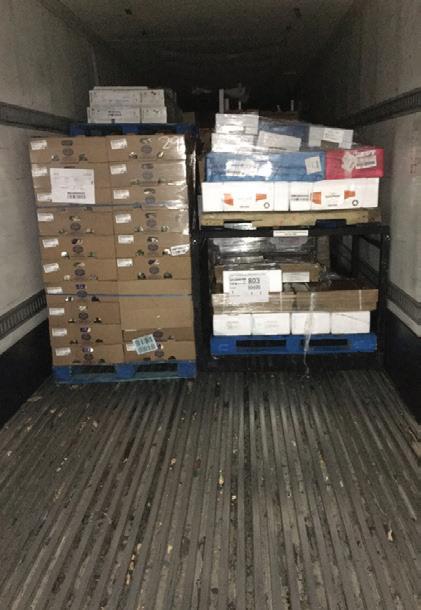
More and more, food companies are seeking innovative ways to achieve end-to-end supply chain visibility. This enables them to track materials, good and products within the supply chain through a clear view of inventory and critical activities.
Through food chain visibility, shippers can automate manual processes and access the information they need to make proactive decisions about their supply chain operations - improving efficiency and the customer experience.
In addition, food chain visibility provides comprehensive insights on how your supply chain is functioning
while ultimately reducing risk. Couple those insights with collections of user data and you can achieve a food chain that can be optimized to be as efficient as possible.
FourKites recently teamed up with Food Shippers of America (FSA) to sponsor current research that sheds light on the most pressing challenges involving visibility of food shippers’ supply chains, opportunities to improve supply chain visibility, and ultimately best practices they have in place to achieve optimum visibility.
FourKites is the world’s leading supply chain intelligence platform, delivering real-time visibility and execution for

Fortune 500 companies and thirdparty logistics firms (3PLs) across 200 countries.
FourKites worked with FSA to deploy an online survey in June 2022 to invite participation by food manufacturers, retailers, distributors, 3PLs and freight brokers that control the transportation and distribution of materials and products in the supply chain. There were 118 participants in the survey, thus ensuring the research initiative is statistically valid. The survey qualified all participants to identify the type and size of company
THROUGH FOOD CHAIN VISIBILITY, SHIPPERS CAN AUTOMATE MANUAL PROCESSES AND ACCESS THE INFORMATION THEY NEED TO MAKE PROACTIVE DECISIONS ABOUT THEIR SUPPLY CHAIN OPERATIONS - IMPROVING EFFICIENCY AND THE CUSTOMER EXPERIENCE.
they represent, and to ensure they have responsibilities in supply chain, transportation, logistics and warehousing. The survey also asked critical questions to gain perspectives on their most pressing supply chain challenges, the most serious disruptors to their operations, the financial impact of product shortages, growth in e-commerce, the use of SKUs, and trends in customer loyalty.
Participants were asked to identify up to three of their most pressing supply chain challenges they are currently facing. Primary challenges are Labor/Talent Management (49.4%), Transportation Capacity Issues (39.2%), Supply/Demand Planning and Disruptions (35.4%), Transportation Rate Issues (29.1%), and Warehousing Capacity Issues (15.2%).
Creating more visibility in your network can help to address
COVID Impact on Labor (55.7%)
Over-the-Road Capacity (44.3%)
Port Delays/Congestion (30.4%)
Changes in Consumer Behavior/ Buying Patterns (21.5%)
Labor/Talent Management (49.4%)
Transportation Capacity Issues (39.2%) Supply/Demand Planning and Disruptions (35.4%)
Transportation Rate Issues (29.1%) Warehousing Capacity Issues (15.2%)
challenges in labor and talent management by increasing productivity across your teams, drastically reducing inbound customer service calls and manual processes. Visibility can enable you to optimize planning and reduce inventory with critical real-time supplier data, while reducing your safety stock and improving your overall forecast accuracy.
Participants also were asked to identify primary disruptors in the past three years, and these were their responses: COVID impact on labor (55.7%), over-the-road capacity (44.3%), Port Delays/Congestion (30.4%), and Changes in Consumer Behavior/Buying Patterns (21.5%).
Food chain visibility can help to address labor challenges that have been exacerbated by the pandemic. In addition, for global food companies struggling with problems generated by port delays and congestion, they can benefit from ocean exception management paired with ocean visibility to ultimately lower transportation costs, reduce demurrage and detention fees, improve customer satisfaction, improve product availability, and generate less spoilage. Lastly, visibility enables food shippers to improve
vendor relations and performance by collaborating in real-time with your suppliers and fulfillment teams, thus increasing your ability to react to changes in buyer behavior and purchasing patterns.
Food chain visibility enables shippers to integrate their transportation, supply and warehouse management systems with order-level detail to ultimately break down silos and create new opportunities for supply chain optimization. Supply chain integration allows you to have a significant impact on avoiding product shortages, or a decline or miss in sales.
The Food Shipper Supply Chain Visibility Report also provide additional perspectives from food shippers, such as how they see grocery e-commerce changing in the coming months, to what degree they’re rationalizing SKUs, the state of customer loyalty, significant initiatives to reduce labor costs, and the impact that rising inflation and geopolitical uncertainty is having on food chains. To download a copy of the Food Shipper Supply Chain Visibility Report, visit www.foodshippers. org, click ‘Resources’ and go to ‘Whitepapers’.
BIGGEST CHALLENGES THE FOOD SHIPPING INDUSTRY FACES
FOOD CHAIN VISIBILITY CAN HELP TO ADDRESS LABOR CHALLENGES THAT HAVE BEEN EXACERBATED BY THE PANDEMIC.
Food shippers are seeking ways to gain visibility into their supply chain to ultimately enhance their capacity. One freight brokerage offering efficient and innovative technology solutions to accomplish this goal is Edge Logistics.

In fact, Edge Logistics has recently leveraged new technology for its top five shippers to enhance integration, participation, and performance management and visibility.

“Capacity for customers allows SMB clients to access the carrier network that enterprise clients have been taking advantage of for some time,” says Will Kerr, President of Edge Logistics. “Most SMB shippers cannot access premium freight broker services because of the case costs involved for the broker. This leads the SMB shipper to a smaller broker who is more customer service and less performance focused. We have solved that problem for the SMB shipper, now they can have both.”
In addition, Edge Logistics uses carrier scorecards as well as GPS visibility via API or online portal so that food shippers know exactly where their trucks are at all times and their anticipated delivery time, continues Kerr. “Our carrier onboarding enables us to vet every carrier on a variety of points while our GPS tracking gives food shippers full visibility every step of the carrier process.”
For additional information, visit edgelogistics.com.
Food Shippers of America gives you access to more market intelligence, best practices, and industry news on critical topics. You’ll find it all through four primary resources:
• FoodShippers.org offers relevant, up-to-the-minute content.
• Food Chain Digest leverages an editorial team with more than 100 years combined experience in transportation, logistics and supply chain.

• Food For Thought features more relevant information, more often.
• Social media channels provide comprehensive information designed specifically for and about food shippers. Make sure to follow us on LinkedIn (corporate page and discussion group), Facebook, Twitter, and Instagram!
Download a 2022 Food Shippers Media Kit at FoodShippers.org or reach out to Cassidy Haley at cassidy@mindshare.bz or 952-442-8850 x215.
Assembly Bill Five (AB5) is still upsetting independent contractors across the California trucking industry since its introduction in 2018. The restrictions it places on independent truck owner/operators has led several groups to protest against the law publicly and fight for their right to own their own businesses. What makes the AB test difficult for independent truck owner/operators to pass, what can be done to stay in compliance with AB5, and what’s on the horizon for independent trucking companies in California?
The California Supreme Court issued an opinion known as the dynamics decision back in 2018, which eliminated the prior worker classification test and instituted the ABC test, according to Chris Shimoda, California Trucking Association (CTA) Senior Vice President of Government Affairs,The ABC test is a three-prong test with section B being the biggest hindrance, adding a significant challenge to owning an independent truck company in California. AB5 was introduced to the California Legislature in 2019 and was passed despite consistent pushback from the California Trucking Association and independent truck drivers.
Greg Feary, President and Managing Partner for Scopelitis Law Firm in Indiana, says AB5’s ABC test is “nearly impossible” to pass for a number of reasons.

“Part of the problem is that you have to, as the motor carrier, prove each of the three prongs,” he says. “If you don't prove any one of them, you lose and your contractor is deemed an employee.”
Feary says the test needing to be met in totality is problem number one. The next issue is motor carriers having to prove that their contractor, who is an owner/operator with their own truck, is not in the same trade profession or occupation as the trucking company.
“I would suspect in California that most California judges will be hard pressed to accept an argument that the truck driver is not in the usual course of business or in the same trade occupation or profession as the trucking company,” he said.
“I think that the sticking combination of having to meet all three prongs, so that if you don't prove one you lose, and in particular that middle prong…
I think that's where you find the test nearly impossible.”
Feary says the putative reason behind AB5 was to make sure all workers would receive all the employment benefits they deserved, though some may see it as a way to advance the cause of union groups to get more workers to join a union and pay dues.
He says there are certain concepts of the ABC test that have applied to truck owner/operators in the past, but AB5 is what he calls “a fairly unique circumstance.”
“It’s somewhat of a ‘perfect storm’ of passing a law that potentially reduces the number of truck drivers in a state that needs every truck driver they can get. And even then, probably doesn't have enough,” he says.

Feary says AB5 causes an additional dip in the number of truck drivers and owner/operators across the state of California and beyond.
“It's interstate trucking where there's substantial contact nexus with the state of California,” he says. “You've got…owner/operators who own their
AB5 is California’s law that requires most industries to use the ABC Test to prove a worker is an independent contractor.





own businesses, that maybe have an older truck. And maybe they're trying to decide whether to buy a new truck, reinvest in their business...go another three, four, or five years. And then this law is created and who they’ve been doing business with are saying, ‘Hey, we can't do business with you under the same model.’ So you're gonna have to go out and become your own motor carrier possibly…there's a lot more cost involved in what you're going to have to do.”
On top of additional credentials and costs, some independent contractors that are close to retirement may choose to transition out of the
industry early. Feary says AB5 is a tipping point for drivers that can lead them to move out of state.


One way for an owner/operator to continue to run their own business is to obtain Federal Motor Carrier Authority, according to Feary. The process includes filing a lot of paperwork and studying compliance and safety regulations, which can seem daunting.

He also says drivers should secure auto liability insurance as well. A $750,000 commercial trucking policy
typically costs owner/operators about $20,000 per year. This could increase an owner/operator's business expenses by at least 20 percent.




In August, the injunction on AB5 was lifted, allowing the law to be enforced in California against interstate trucking. Feary said the CTA will move forward at the Federal District Court in San Diego to seek another injunction.
He says independent owner/operators should stay in communication with their motor carriers and gain an understanding of the carrier's plans on how to move forward.
FEARY SAYS INDEPENDENT OWNER/OPERATORS SHOULD STAY IN COMMUNICATION WITH THEIR MOTOR CARRIERS AND GAIN AN UNDERSTANDING OF THE CARRIER'S PLANS ON HOW TO MOVE FORWARD.
There are many recent world events that have placed extraordinary pressures on food chains. With all these pressures, Food Shippers of America (FSA) continues to support organizations that can have a significant impact on its members operations and success. In fact, in 2022 FSA has chosen to provide financial resources to the following organizations:



This industry non-profit exists to provide supply chain assistance to disaster relief organizations and other non-profits. ALAN does this by bringing together the expertise and resources of the logistics industry with non-profit disaster relief organizations so that ALAN can help solve their most pressing supply

chain challenges immediately after disasters strike. That way, help and op arrive sooner.
Just as important, ALAN helps humanitarian organizations make every logistics dollar count. After all, studies show that up to 80 percent of their crisis spending goes to logistics. And of that, as much as 40 percent may be wasted simply because these organizations do not have access
knowledge or connections.
In March, FSA renewed its ALAN Sustainer Sponsor status in 2022 –which continues a supportive relationship FSA has maintained with ALAN for more than a decade.

“In the past two years alone, ALAN has enabled the delivery and distribution of more than $10 million in relief supplies for hurricanes, floods, tornadoes, and the pandemic,” says ALAN Executive Director Kathy Fulton. “That’s only possible because of the support of organizations like Food Shippers of America, whose generous donation came at the start of a year already bustling with requests for disaster aid.”
For more information, visit alanaid.org.
In a country that wastes billions of pounds of food each year, it’s almost shocking that anyone in America can go hungry. Yet every day there are millions of children and adults who do not get the meals they need to thrive.
Feeding America is the largest domestic hunger-relief organization in the U.S. – and has a natural tie-in to the food industry. For this reason, in 2022 FSA has made a substantial financial commitment to support Feeding America.
Thanks to the donation by FSA as well as thousands of other businesses, government organizations, and individual Americans, the Feeding America network of food banks, pantries and meal programs serve virtually every community in the
THE FEEDING AMERICA NETWORK OF FOOD BANKS, PANTRIES AND MEAL PROGRAMS SERVE VIRTUALLY EVERY COMMUNITY IN THE UNITED STATES – 40 MILLION PEOPLE, INCLUDING 12 MILLION CHILDREN AND
MILLION SENIORS.
pallet fit™ door fits any pallet height







reduces labor
works with full, partial, or single layer pallets
no more need for plug pallets, zone can run with one or multiple empty pallet

increased airflow
more
more
20,000+ QFR pallet positions installed and the qfr zone® is still the most efficient blast freezing solution ever!

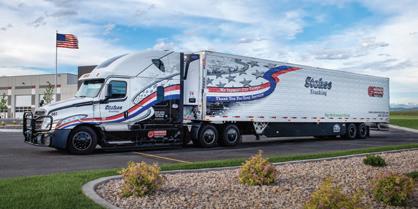






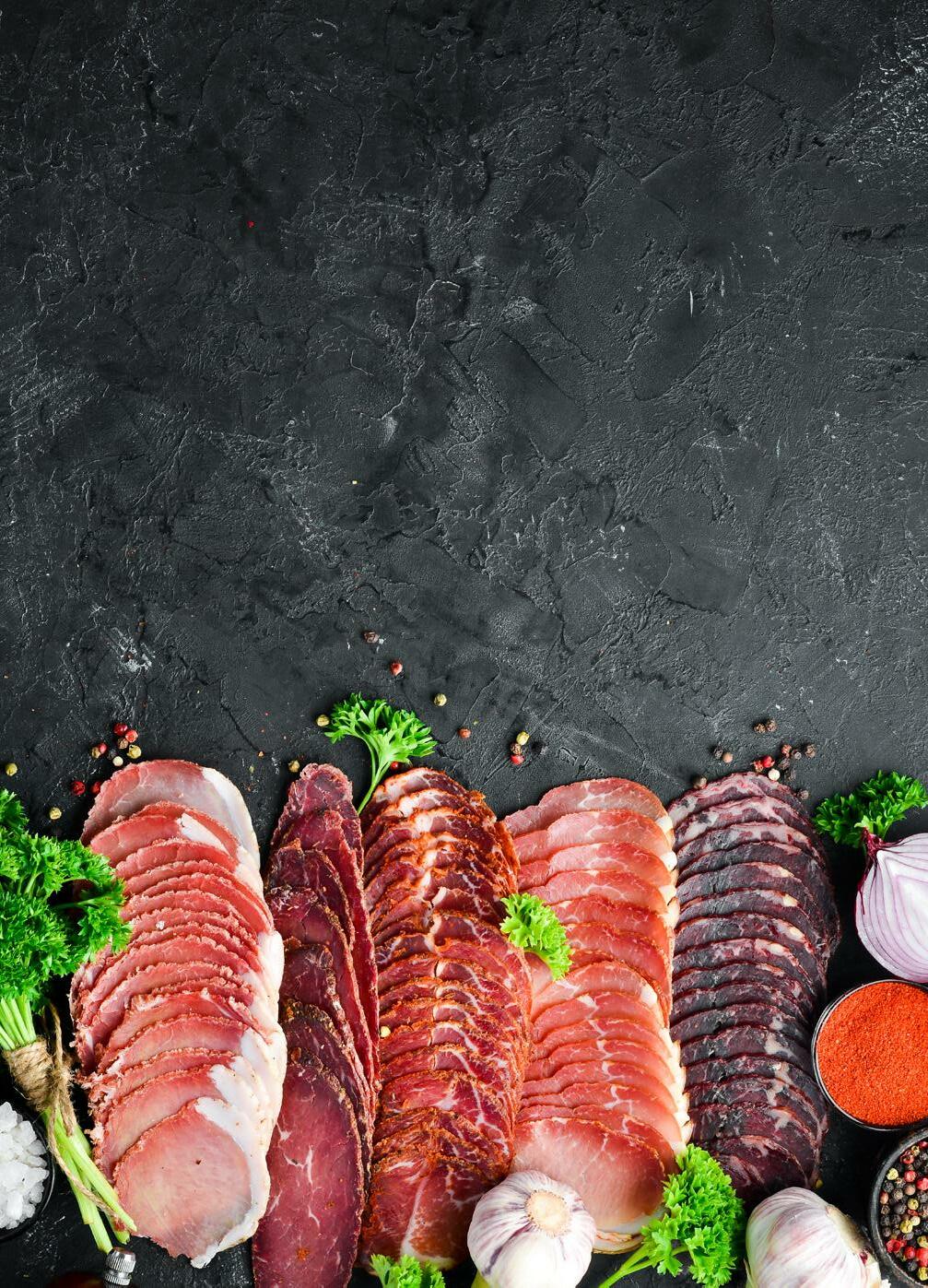
United States – 40 million people, including 12 million children and 7 million seniors. In fact, the Feeding America network has provided more than 6.6 billion meals, helping one in seven people facing hunger live more secure and stable lives.

Second Harvest Food Bank: Making a Difference for Those in Need

Second Harvest Food Bank of Central Florida is a private, nonprofit organization that collects, stores and distributes donated food to more than 500 feeding partners in six counties

in central Florida: Brevard, Lake, Orange, Oscola, Seminole and Volusia. This charity was chosen specifically because FSA hosted its Food Shippers Annual Conference in Orlando in February of this year, and wanted to contribute to the local area in which the conference was hosted.
FSA has made a financial donation in 2022 to Second Harvest Food Bank of Central Florida.

Last year, with the help of numerous donors like FSA, the food bank distributed enough food for 97 million
meals to partner programs such as food pantries, soup kitchens, women’s shelters, senior centers, day care centers, and Kids Cafes.
“Food Shippers of America has consistently contributed to worthwhile organizations such as ALAN, Feeding America, and Second Harvest,” says Paul Newbourne, Executive Director of FSA. “We feel it’s important for our organization to support non-profits and charities that have a direct and positive influence on the lives of others.”
“WE FEEL IT’S IMPORTANT FOR OUR ORGANIZATION TO SUPPORT NON-PROFITS AND CHARITIES THAT HAVE A DIRECT AND POSITIVE INFLUENCE ON THE LIVES OF OTHERS.” - PAUL NEWBOURNE


THE FOOD SHIPPERS OF AMERICA (FSA) 67TH ANNUAL CONFERENCE WILL TAKE PLACE MARCH 5-7, 2023, AT THE J.W. MARRIOTT DESERT SPRINGS IN PALM DESERT, CALIF.
In addition to ample opportunities to network with your peers and providers, this three-day event will feature nationally recognized professional speakers, academic scholars, and high-level executives within the food, beverage and logistics industry, including:
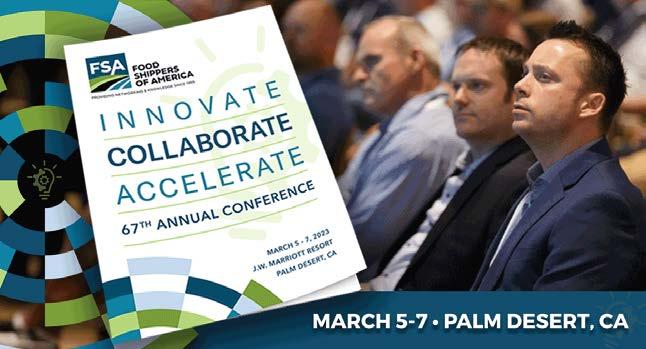

Founder and CEO of sportwear company FUBU and star of ABC’s Shark Tank, Daymond John, will share his philosophy and business practices that helped him achieve personal and professional success.


Shelley Simpson, President at J.B. Hunt Transport, will highlight where the industry has been, where it is today, and where it needs to go to move forward

in the areas of diversity, equity, and inclusion within the supply chain. Such initiatives can drive innovation, acceleration and growth in any business.
Tracy Rosser, Executive Vice President, Operations at Transplace will talk about what is around the corner with data visibility, new transparent platforms, connectivity, and integration technology that will drive supply chain networks into the future.




Discussion on the “pros versus cons” on the virtues of traditional and digital brokerage, and highlighting similarities and differences to the approach. Shippers will gain perspectives on how to collaborate brokerage solutions that fit their food chain needs.
Moderator Alyssa Correale, Senior Vice President Strategic Fleet Partnerships, Uber Freight along with panelists: Russell Leo, CEO, RLS Logistics; Joe Dagnese, CEO, Peco Pallet; Adam DeGroot, CEO, DeGroot Farms Beach; and Mario Cordero, Executive Director, Port of Long Beach. These industry leaders will provide insights as to how innovation, collaboration, and acceleration can help drive success in today’s supply chain.


Chris Caplice, Executive Director for the MIT Center for Transportation & Logistics and Chief Scientist DAT Freight and Analytics, will review available tools and techniques that can be used to better prepare organizations for a future that is ever changing and unpredictable.



Andrew Whitworth talks about his success in the NFL, being the oldest tackle in NFL history, the oldest offensive lineman to win a super bowl, and how the principles that guided him to success can be applied to businesses and personal lives every day. Named the 2021 Walter Payton NFL Man of the Year, Whitworth also discusses the importance of giving back to the community.
“With all the disruption and challenges going on in the supply chain these days, we developed the theme ‘Innovate. Collaborate. Accelerate.’ and it has hit home for many food shippers,” says 2023
FSA Conference Chair Mark Purdy, Senior Manager
Dry National Transportation Strategy & Operations, General Mills. “We have developed a comprehensive agenda around this theme to ensure it’s as relevant as possible to our attendees.”
- Mark Purdy, Conference Co-Chair, General Mills
Ethel “Stephanie”
Stuckey, CEO of Stuckey’s Corp., highlights the turnaround success story of Stuckey’s, and how to use innovate, collaborate, and accelerate concepts to win in the marketplace.

Bob Costello, Chief Economist & Senior Vice President at the American Trucking Associations (ATA), returns to present current key economic data and its effects throughout the supply chain.

New for the 2023 conference is an exclusive member only networking event on Sunday afternoon where FSA member shippers and receivers can meet to discuss the supply chain and logistics challenges that they are collectively facing in today’s dynamic market environment.

For more information on the 67th Annual Conference, visit foodshippers.org. (Note: Agenda subject to change so check back to the website often).








Running late can hurt your reputation. That’s why Penske offers customized transportation and logistics solutions, drawing from real-time data to optimize shipments, minimize disruptions and improve fleet efficiency.

